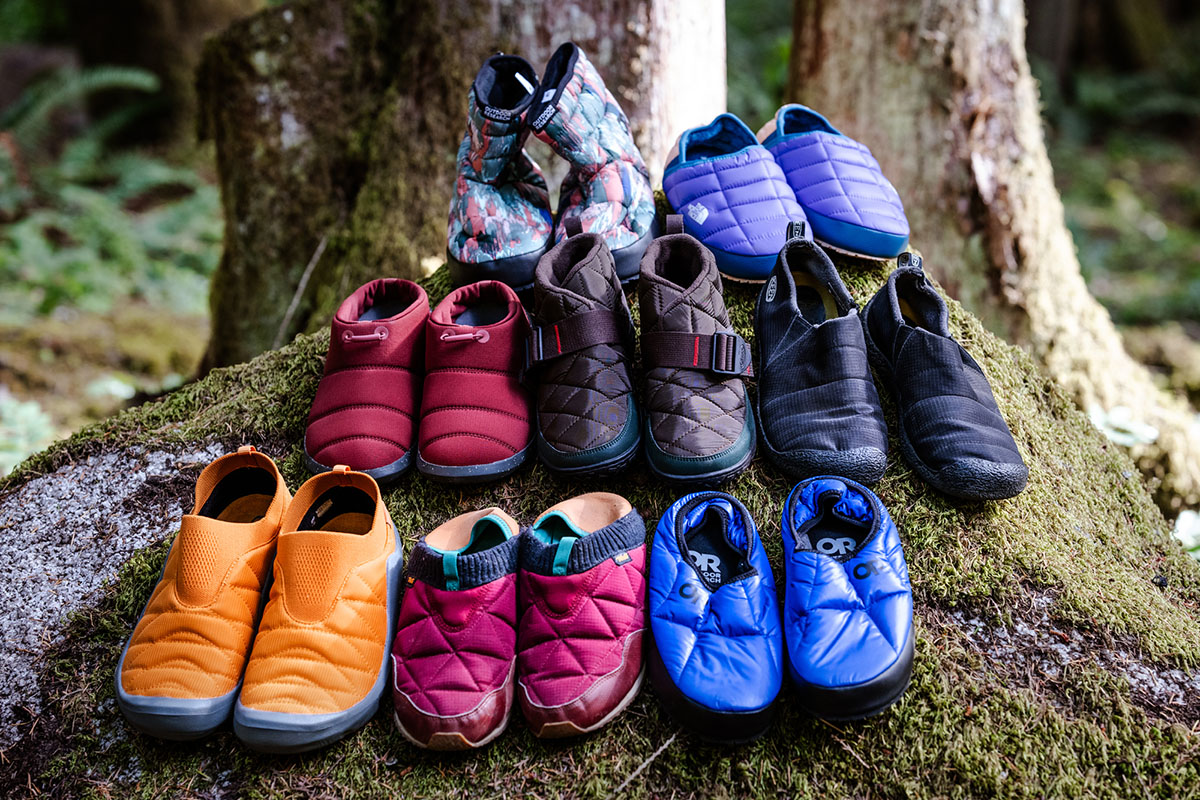
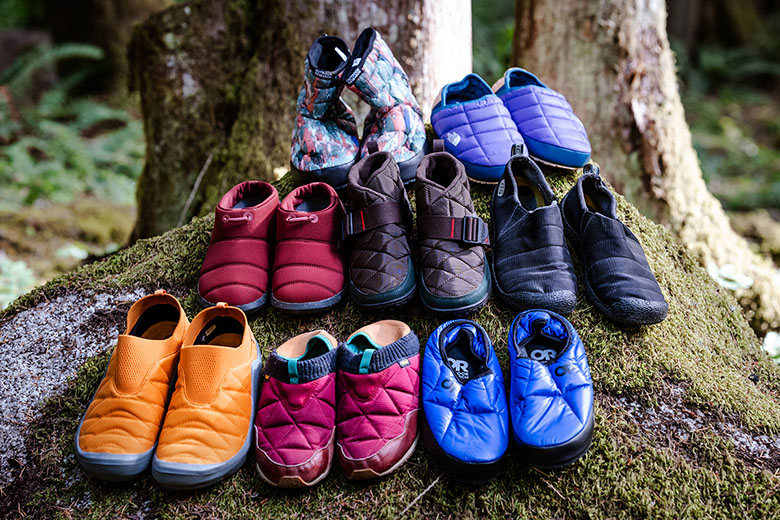
Camp shoes come in all shapes and sizes, from comfy slippers for hanging around the campground or cabin to ultralight sandals that allow your feet to splay and breathe after long days outside. Recovery shoes are also gaining popularity among endurance athletes looking to maximize comfort after big efforts. No matter the style, all camp shoes share a few basic characteristics, including easy on and off, outdoor-ready constructions, and enough support and grip to cover at least short distances. After extensive testing on adventures near and far—from camping and backpacking trips in the North Cascades to après ski at resorts throughout the Mountain West—we’ve hand-picked our 17 favorites for 2025. For more background information, see our comparison table and buying advice below the picks, along with details about our testing process.
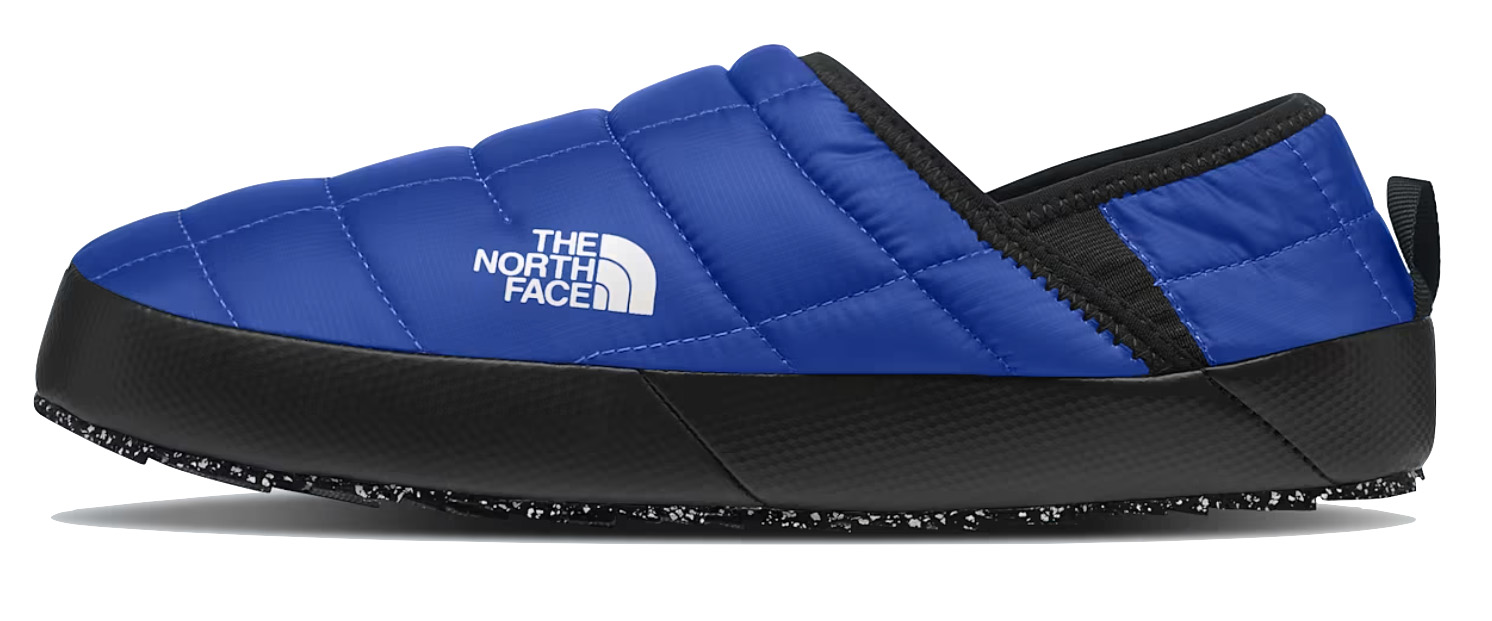 Category: Slipper
Category: Slipper
Closure: None
Weight per pair: 1 lb. 0.3 oz.
What we like: Plush interior, great traction, and very easy to get on and off.
What we don’t: Runs narrow; upper is more prone to tears and snags than some alternatives.
Camp shoes come in many forms, with outdoor slippers being our go-to for camping, road trips, or simply lounging around the house. The North Face’s ThermoBall Traction Mules V are a real standout in this category, combining excellent comfort and traction (true to their name) in an affordable package. The fleece lining along the interior is incredibly soft, the synthetic ThermoBall insulation mimics down’s plush warmth without immediately wetting out when exposed to moisture, and the outsole has ample grip for short outings from camp that don’t warrant donning your hiking boots. We also love the collapsible heel—great for instances when you don’t need your foot locked in, which is, realistically, most of the time—and the nice selection of bright colorways and fun patterns.
The ThermoBall Eco Traction Mules V aren’t without flaws, however. The first is the narrow fit: Our average-footed tester found them to be comfortably snug, but many users report needing to go up at least a full size. The upper also has a slightly slippery feel and strikes us as more susceptible to snags and tears than some alternatives, including Teva’s popular ReEmber Slip-Ons below. Finally, the ThermoBall’s fleece lining will pack out over time, but it has a big impact on comfort and gives the Traction Mules a much more luxurious feel than the Tevas. As long as you’re able to dial in the right size, the TNF slippers offer a hard-to-beat combination of comfort, grip, and affordability. They’re also sold in a higher-cut bootie version for $10 more.
See the Men's TNF ThermoBall Traction Mules See the Women's TNF ThermoBall Traction Mules
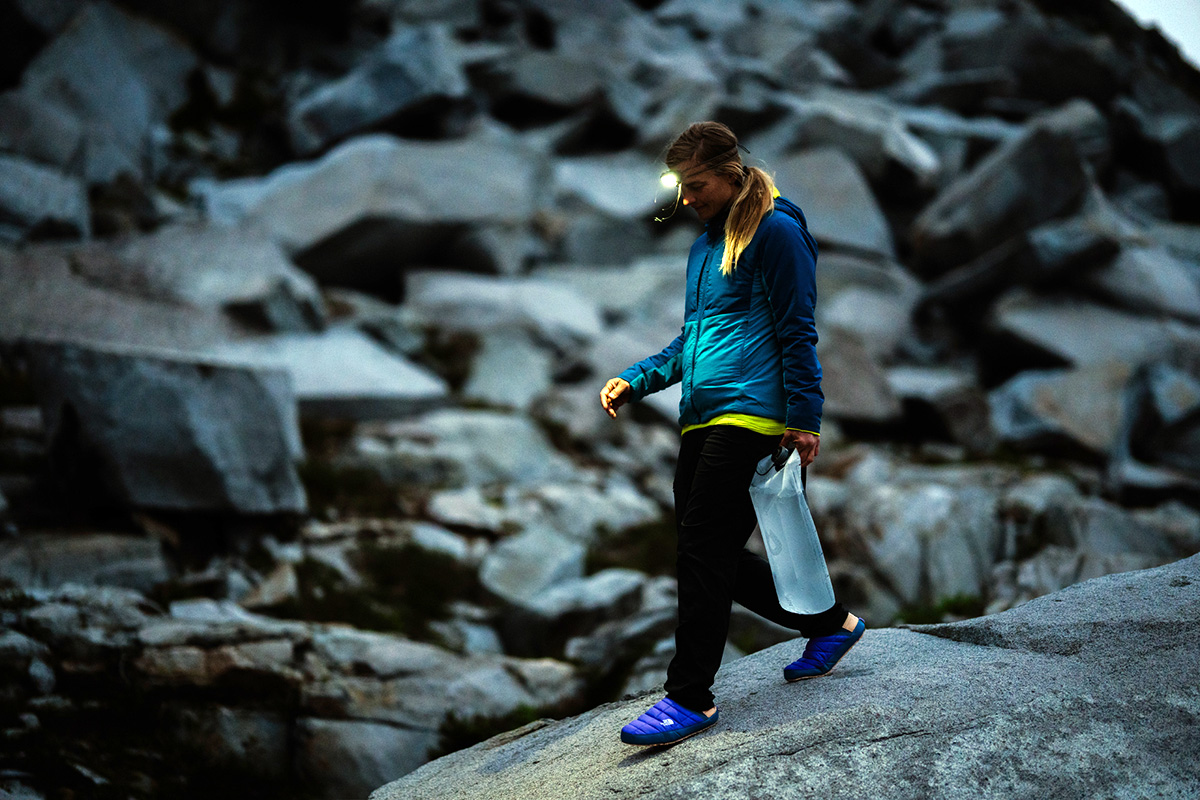
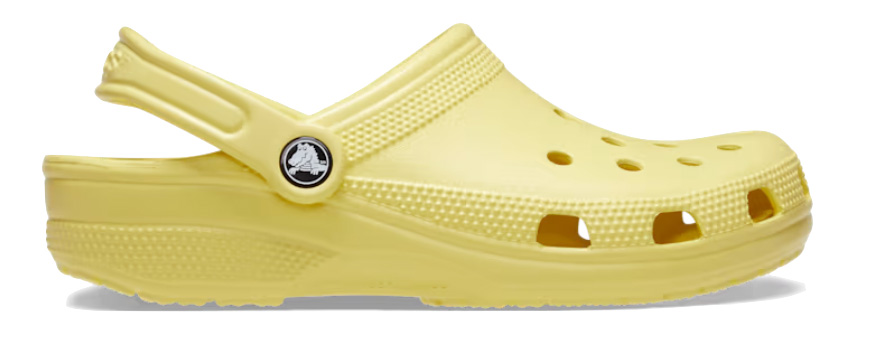 Category: Clog
Category: Clog
Closure: None
Weight per pair: 14.0 oz.
What we like: Lightweight, very versatile, and offered in a ton of fun colorways.
What we don’t: Polarizing looks, lacking in arch support, and take time to break in.
When Crocs first hit the market in the early 2000s, they were met with a mix of curiosity and jeer. But despite the initial skepticism, Crocs have skyrocketed to popularity over the years, and perhaps no demographic has embraced them as wholeheartedly as the outdoor community. Price and versatility are the biggest selling points: These kicks cost just $50, are quick to slip on and off, and can be worn just about anywhere—we've seen them at campgrounds, on the water, in the grocery store, and even at the crag. The all-foam build is another highlight, giving the shoes a very light and airy feel, and the heel strap is easy to deploy for added security. Due to the shoes’ widespread popularity, many people even customize their Crocs with charms, which can be threaded through any of the holes in the upper. Tack on availability in tons of fun colorways, and it’s no wonder why Crocs have gained a cult-like following over the years.
All that said, Crocs aren’t for everyone. While they’re a pretty common sight outdoors these days, the Classic Clogs have a decidedly polarizing look and feel, especially out of the box. The good news is that they wear in quickly and are wide enough to accommodate high-volume feet or thick socks, but the lack of arch and heel support is notable (those with high arches may want to consider aftermarket insoles or simply look elsewhere). Additionally, while the holes in the upper do a decent job promoting airflow, the shoes can grow clammy in warm temperatures, which is a recipe for blisters and smelly feet. But we keep coming back to value: The Classic Clogs cost just $50, look the part both outdoors and around town, and are comfortable to wear on short outings from camp or when running errands. For a more water-friendly option with similar styling, check out Merrell’s Hydro Moc, which features a more porous upper and added coverage over the heel and forefoot.
See the Crocs Classic Clog
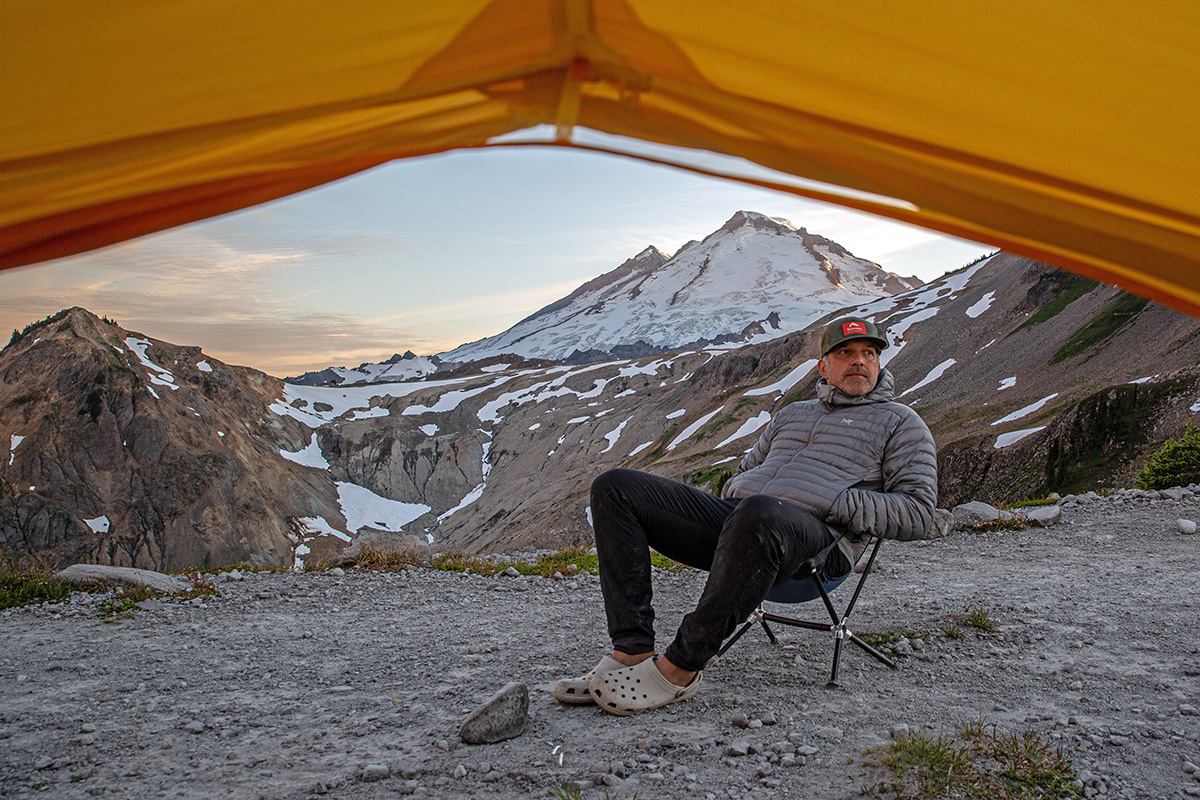
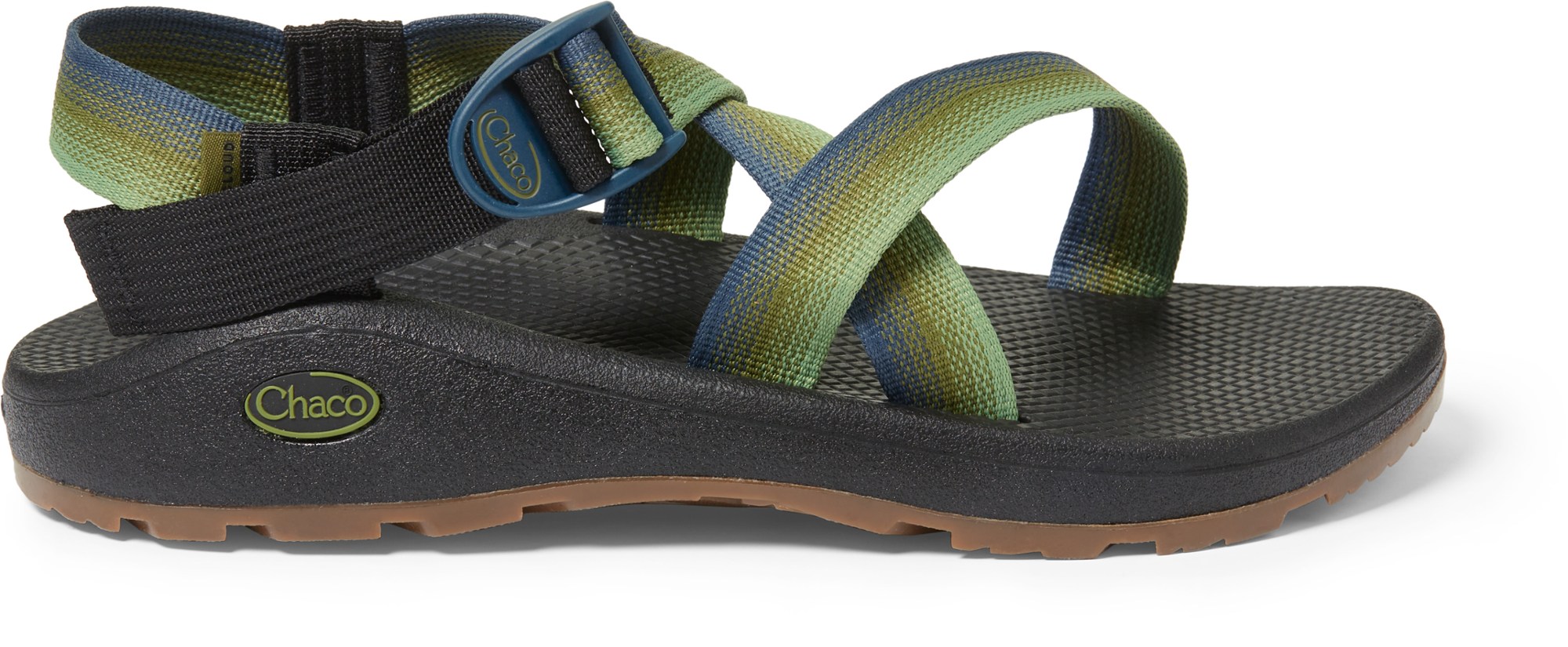 Category: Sandal
Category: Sandal
Closure: Strap (buckle)
Weight per pair: 1 lb. 14.1 oz.
What we like: Excellent durability, support, and grip over a wide variety of surfaces.
What we don’t: The heaviest option on our list and bulkier than many designs here.
Chacos are legendary among outdoor-goers of all kinds, from hikers and backpackers to climbers and paddlers. From their extensive selection, we’re big fans of the Z/Cloud in particular—it's been our favorite hiking sandal for many years running. As we’ve come to expect from the brand, the Z/Cloud features a comfortable and well-cushioned midsole, deep lugs for digging into softer surfaces like mud and sand, and thick straps that effectively secure the heel and forefoot. There’s no toe loop, which some prefer for added control and stability, but we like the open design for pairing with socks. And from a durability perspective, Chacos consistently outlast most other shoes in our closet—we’ve had pairs withstand up to three full years of consistent use or more before needing to be resoled or replaced.
The Chaco Z/Cloud’s biggest downsides are its heft and bulk. At nearly 2 pounds for the pair, these sandals are heavier than many lightweight hiking shoes, so they aren't our first choice for strapping to the outside of a pack (although we’ve certainly seen it done). In other words, if you’re looking for a pair of shoes to tote into the backcountry and wear once you reach camp, we’d recommend checking out an alternative like the Luna Leadville Pacer or Bedrock Cairn Evo below, both of which are considerably lighter, though a step down in support and structure. A final downside to the Z/Cloud is that the strap system is a little finicky and difficult to fine-tune, but once you get a good fit, you shouldn’t need to mess with it again. All in all, we can’t sing enough praises about Chacos and consider them one of the best daily drivers in the summer, whether we’re approaching a sport climbing crag or enjoying a rest day by the river.
See the Men's Chaco Z/Cloud See the Women's Chaco Z/Cloud
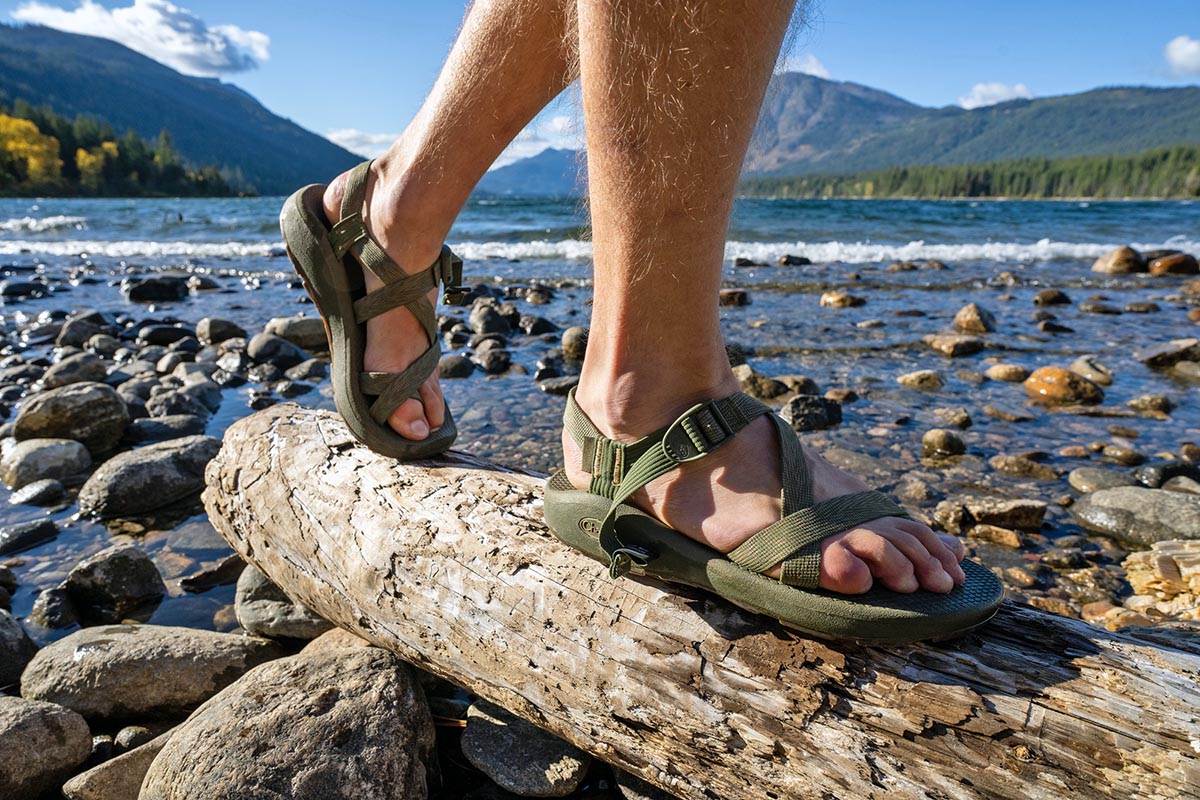
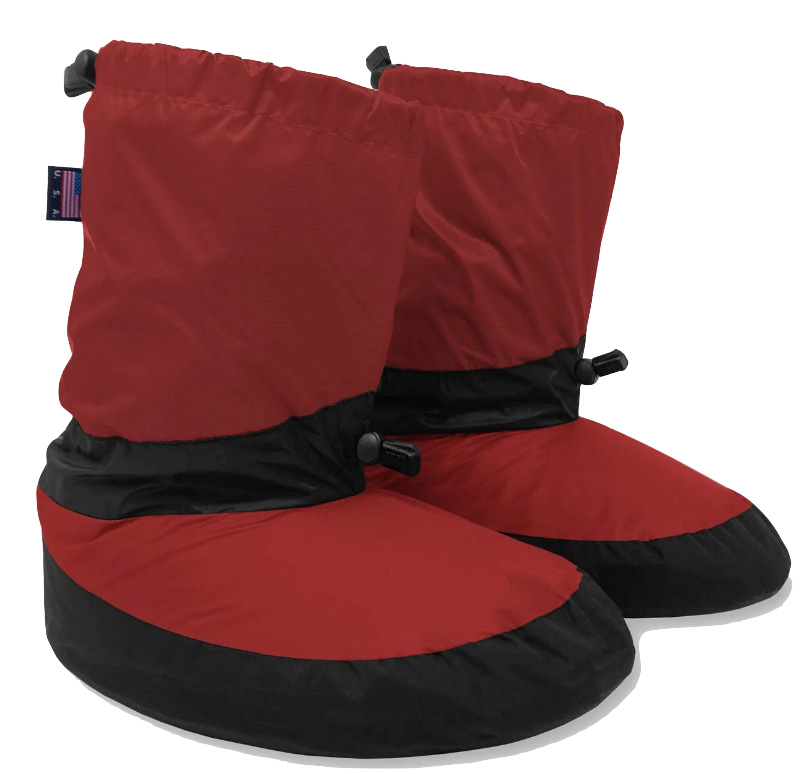 Category: Bootie
Category: Bootie
Closure: Drawcords (ankle and cuff)
Weight per pair: 9.3 oz.
What we like: Lofty down insulation and weather-resistant shell are great for cold-weather use.
What we don’t: Pricey and won’t replace a true winter boot when in the snow.
Feathered Friends is a down specialist with an extensive lineup of lofty sleeping bags and cold weather-ready jackets. Unsurprisingly, their Down Booties are a favorite among winter adventurers, whether you’re spending the night in a tent or cozied up in a backcountry hut. In addition to providing better coverage than slippers like the TNF Traction Mules above and Teva ReEmber Slip-Ons below, the Down Booties tack on a more weather-resistant Pertex Endurance shell for fending off the elements, a fully waterproof sole, and drawcords at both the ankle and cuff for sealing out cold drafts. And when it’s time to hit the hay, simply ditch the outer shell and crawl inside your sleeping bag wearing the removable liner, which is packed with 800-fill-power goose down that’s remarkably warm for its weight.
However, it’s important not to mistake the Feathered Friends Down Booties for a true winter boot. While perfectly serviceable for waiting out storms in a tent or cozying up by the fire on a backcountry hut trip, the Down Booties lack the traction and security needed to move around efficiently in the snow. The inner sock slides freely within the outer shell, which can lead to instability when navigating uneven ground, and there’s minimal insulation between the bottom of your foot and the snow. But if you struggle with cold feet on winter camping trips and don’t plan to venture outside for more than the occasional bathroom break, the Down Booties could be just the ticket. For a cheaper option that uses slightly lower-quality (700-fill) down, check out Exped’s Down Socks, which forgo the waterproof sole and separate shell (they’re intended to be worn inside your tent but not around camp).
See the Feathered Friends Down Booties
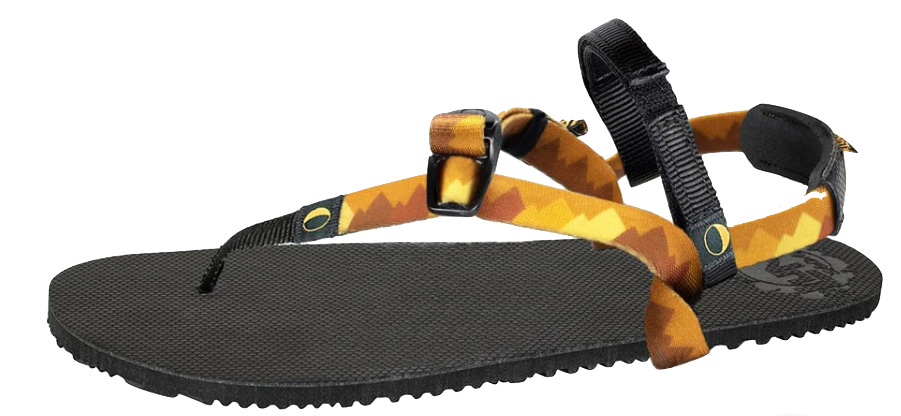 Category: Sandal
Category: Sandal
Closure: Strap (buckle & Velcro)
Weight per pair: 8.9 oz.
What we like: Extremely light, compact, and capable for trips into the backcountry.
What we don’t: Limited support and structure; toe thong isn't compatible with regular socks.
Backpackers focused on keeping weight to a minimum may balk at bringing along a pair of camp shoes, but we think a feathery and foldable sandal like Luna’s Leadville Pacer is well worth it on most trips. At just 8.9 ounces for the pair and with a very low profile and flexible build, the Leadville Pacer takes up minimal space in a pack and will give your feet some much-needed reprieve after long days on the trail. In fact, despite their minimalist appearance, these sandals are far more comfortable than expected thanks to Luna’s well-executed harness system and moveable buckles that make it easy to fine-tune the fit. And should your feet need a break from your hiking shoes even sooner, the Vibram outsole offers ample grip on most terrain—from slick creek crossings to boulder hopping (just be careful to avoid scraping your exposed toes).
Luna’s Leadville Pacer is particularly popular among barefoot runners, which speaks volumes for their overall capability and on-trail performance. That said, there’s no getting around the fact that these are minimalist sandals, and as such, they’re noticeably lacking in arch support compared to alternatives like Chaco’s Z/Cloud above. They’re also hard to pair with socks due to the toe strap, although you could always opt for a pair of Injinjis. Alternatively, Luna offers a unique solution in their Tabu 2.0—a split-toe, water-resistant bootie for added coverage and protection. Regardless of how you choose to wear them, the Leadville Pacer sandals are a great solution for weight- and space-conscious backpackers who want something capable enough to take on hiking duties in a pinch. For $10 less but around 2 ounces more per pair, Luna’s Mono Winged Edition is another staff favorite with a beefier outsole and additional cushioning underfoot.
See the Luna Sandals Leadville Pacer
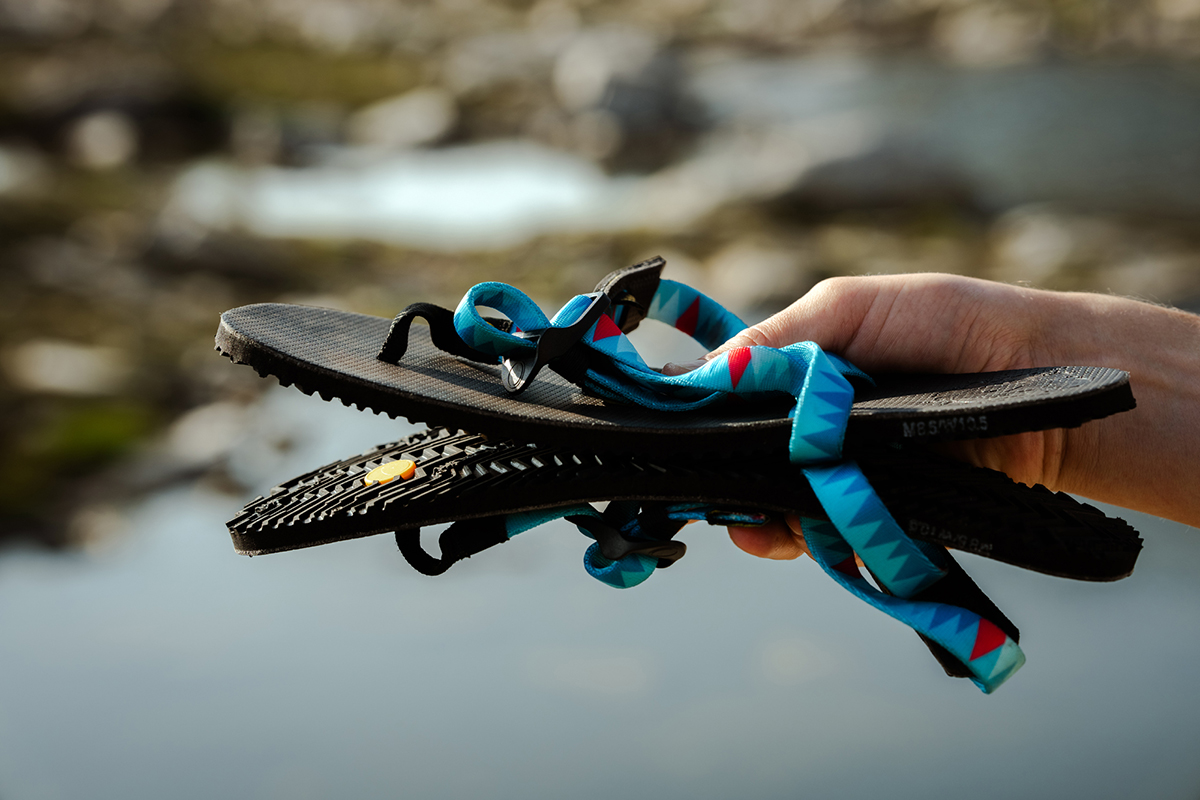
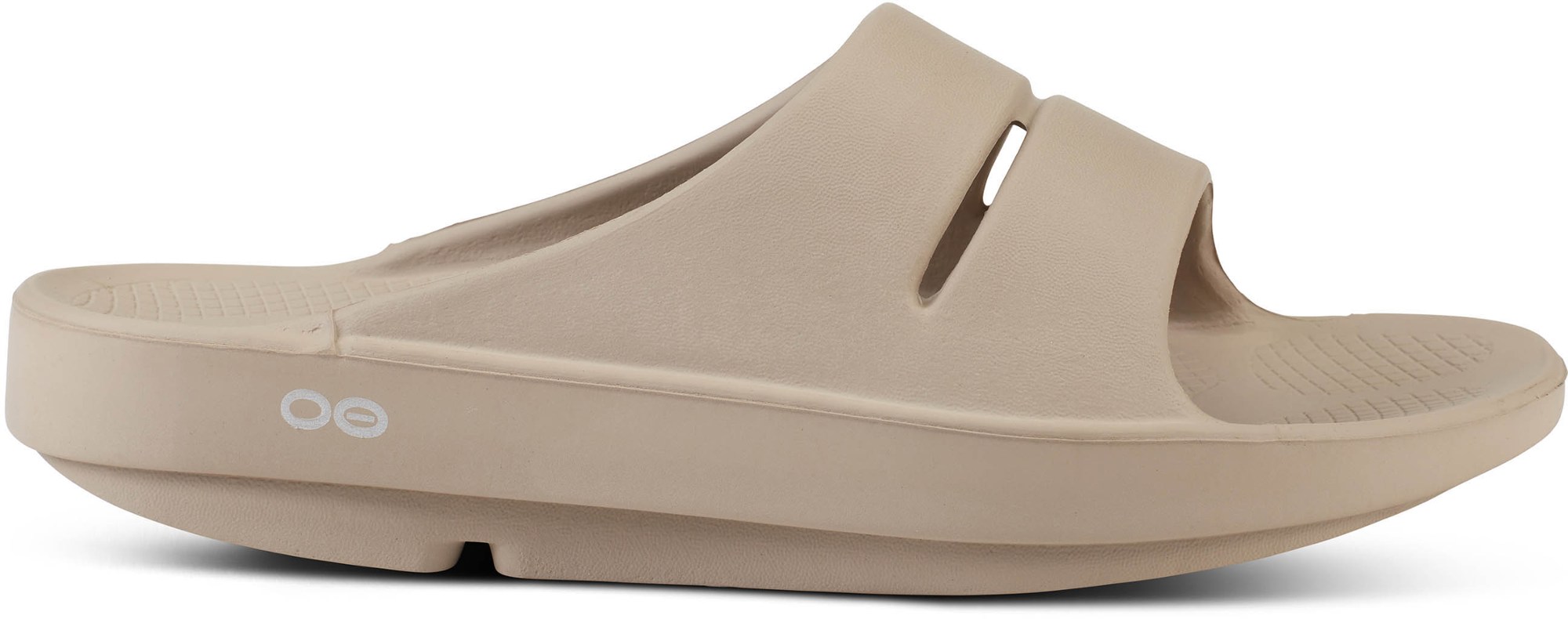 Category: Recovery
Category: Recovery
Closure: None
Weight per pair: 9.6 oz.
What we like: Thick cushioning is great for letting your feet recover after serious efforts.
What we don’t: Lacking in versatility and stability.
As ultra-distance running and other endurance sports have gained popularity in recent years, we’ve seen a new category of footwear emerge: recovery shoes. Designed to give your feet a break after long efforts, these kicks prioritize comfort above all else with generous padding and support. Our favorite recovery design this year is Oofos’ Ooahh Slide, which boasts thick, springy cushioning in a lightweight and easy-wearing package. Slipping our feet into the Ooahh for the first time, we were struck by the shoes’ cushy and forgiving feel, which was a very welcome reprieve for our tired feet that had just endured several hours crammed inside rock climbing shoes. We’ve since turned to these slides after long runs and when dealing with issues like bone spurs and plantar fasciitis, and each time, they’ve provided a noticeable boost in comfort compared to the non-recovery slippers and sandals in our closet.
However, while we love recovery shoes for giving tired and sore feet a break, they’re not a great daily driver. First, while the Ooahh Slide’s rockered profile helps promote a smooth stride, it also results in a bit of a tippy and off-balance ride (the thick cushioning certainly doesn’t help). Second, while we found the fit to be spot-on in our usual size, some users report the shoes being too narrow. Oofos only offers the slides in full sizes, so we’d highly advise trying them on before you buy to make sure the shape will work. But if you can nail the fit and don’t mind the inherent trade-offs in stability, the Ooahh is a very comfortable place to be after long runs, multi-pitch climbs, and other foot-intensive efforts. And if you prefer to have your big toe separated from the rest of your digits, Oofos’ Ooriginal sandals are largely identical apart from the Y-shaped strap.
See the Oofos Ooahh Slide
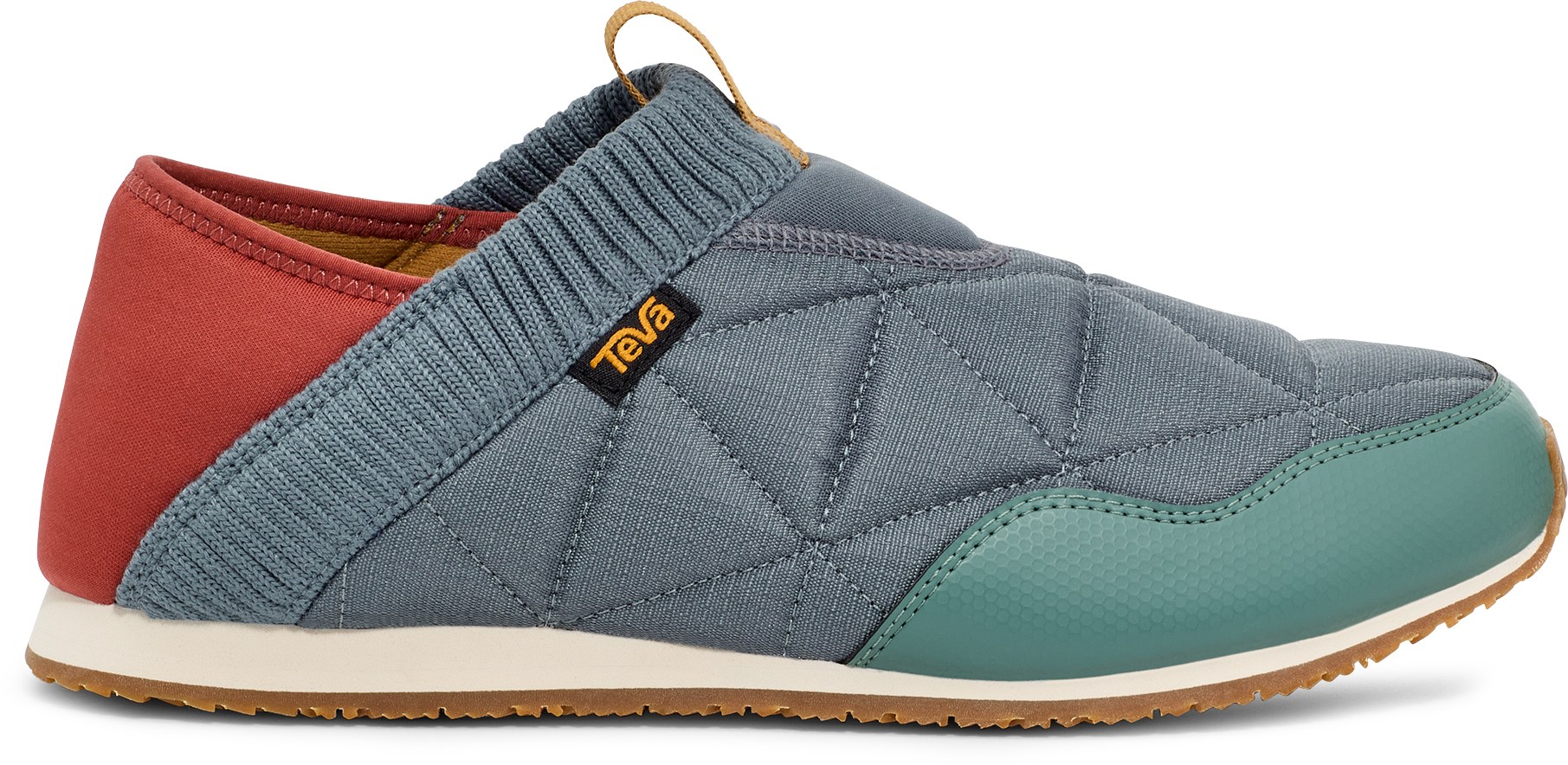 Category: Slipper
Category: Slipper
Closure: None
Weight per pair: 1 lb. 2.0 oz.
What we like: Fun styling, comfortable to wear with or without socks, and built to last.
What we don’t: Not the plushest or grippiest option.
Along with The North Face’s Traction Mules above, Teva’s ReEmber slippers are one of the most ubiquitous camp slippers on the market, and for good reason. While less plush inside than the Traction Mules, the ReEmber Slip-Ons are comfortable to wear with or without socks (the TNF’s fleece lining can lead to sweaty feet), extremely easy to get on and off, and very durable with hardwearing materials throughout. In fact, after nearly three years of near-daily use, our pair is in excellent shape apart from some fraying along the heel, which is to be expected considering we keep it folded down far more often than not. Tack on thoughtful details like a rib-knit collar, beefy toe cap, and nice selection of fun colorways (including both solid and multi-toned options), and it’s clear why the ReEmber has garnered such a loyal following over the years—many of our staff included.
What keeps the Teva ReEmber from dethroning the TNF Traction Mules as our top pick? In addition to being slightly heavier, the Teva is around $20 pricier and a step down in traction with a flat rubber outsole that provides minimal grip on surfaces like gravel or slush. Teva does offer the shoes in a Terrain version that swaps in more aggressive lugs, but it lacks the standard model’s collapsible heel and costs $10 more. The ReEmber is also relatively bulky-feeling with the mix of materials and thick toe cap, although the advantages in protection and durability are notable. Finally, the Teva’s polyester interior isn’t particularly plush compared to the Traction Mules’ soft fleece lining, but we do appreciate that it holds up well over time (the TNF’s fleece is more susceptible to wearing down and packing out with frequent use). In the end, we think the Traction Mules balance their priorities a bit better, but the ReEmber remains a staple in our wardrobe for everything from after-work bouldering sessions to running errands around town.
See the Teva ReEmber Slip-Ons
 Category: Sandal
Category: Sandal
Closure: Strap (buckle & Velcro)
Weight per pair: 15.6 oz.
What we like: Premium Vibram outsole and considerably lighter than the Chaco Z/Cloud above.
What we don’t: Lacking in arch support; not everyone will love the Y-shaped strap.
Bedrock Sandals’ Cairn Evo is legendary in the hiking sandal market, and for good reason: The design is light, flexible, and low-profile, giving it a barely-there feel even as the miles add up. You also get good all-around adjustability via a buckle at the front and Velcro at the rear, making it relatively easy to fine-tune the fit around different parts of the foot. And with a premium Vibram outsole, the Cairn Evo is much better equipped than most designs here for navigating tricky terrain, from packed dirt to slick rocks and blowdowns along the trail. Added up, if you’re looking for a nice middle ground between the hefty Chaco Z/Cloud and more streamlined Luna Leadville Pacer above, the Cairn Evo strikes a very compelling middle ground.
That said, the Carin’s minimalist, zero-drop design isn’t for everyone. One editor who’s an ultra-distance trail runner had no issues backpacking in the sandals for multiple days after getting blisters from her hiking boots, while another with wider feet experienced significant soreness and achiness after an 8-mile trek around Mexico City. In other words, those with finicky feet or who suffer from arch problems will likely want to upgrade to a more supportive option like Chaco’s Z/Cloud above. The Y-shaped strap at the front may also pose issues for some, including irritation between the toes and/or rubbing around the ankle, but again, this is largely dependent on the shape of your foot. In the end, it’s for good reason that the Bedrock Cairn has become a common sight in the backcountry: It’s lightweight, impressively grippy, and substantial enough to give your feet a break not only at camp but on the trail, too.
See the Bedrock Sandals Cairn Evo
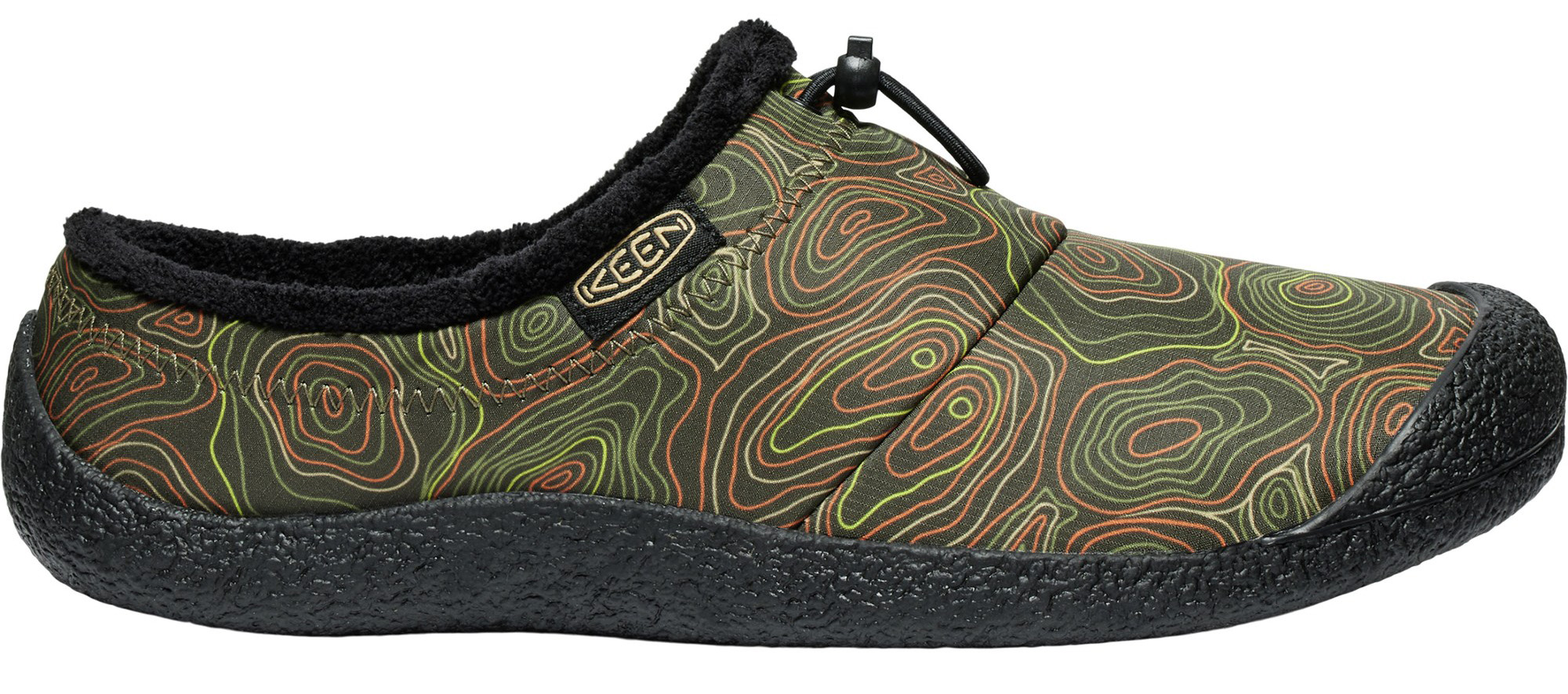 Category: Slipper
Category: Slipper
Closure: Drawcord (cuff)
Weight per pair: 1 lb. 7.4 oz.
What we like: Well built with comfortable and long-lasting materials.
What we don’t: Fairly dated look and feel; fit runs noticeably large.
Keen’s Howser was this author’s first camp shoe and won her over very quickly. While relatively basic, the slip-on design makes the shoes incredibly easy to get on and off, and the bungee cinch over the forefoot is a nice touch for locking things down when you need the added security. The rest of the design is equally well executed, including cozy fleece lining the inside and a beefy rubber outsole that extends up and over the front, back, and sides for comprehensive protection. The upper is made of synthetic or felt, depending on the colorway, but both materials strike us as hardwearing and tear-resistant. Taken together, the Howser III Slide is a high-quality camp slipper that will handily outlast the TNF Traction Mules above (for a considerable $41 more).
As we touched on above, the Howser introduced us to the camp shoe category and was such a hit that we quickly purchased pairs for our partner and parents. But this is telling: While our parents still love the shoes, our partner has since upgraded to the Teva ReEmber above for its lighter and lower-profile feel. The Howser is also more dated-looking than the ReEmber and only sold in a handful of relatively dull colorways. And we’d be remiss not to touch on fit, which runs noticeably large—we opted for our usual size in the Howser and were swimming in the shoes, even when wearing thick socks. But if you like the styling and can nail the fit, the Howser remains one of our all-time favorites for its high-quality build that stands the test of time.
See the Men's Keen Howser III Slide See the Women's Keen Howser III Slide
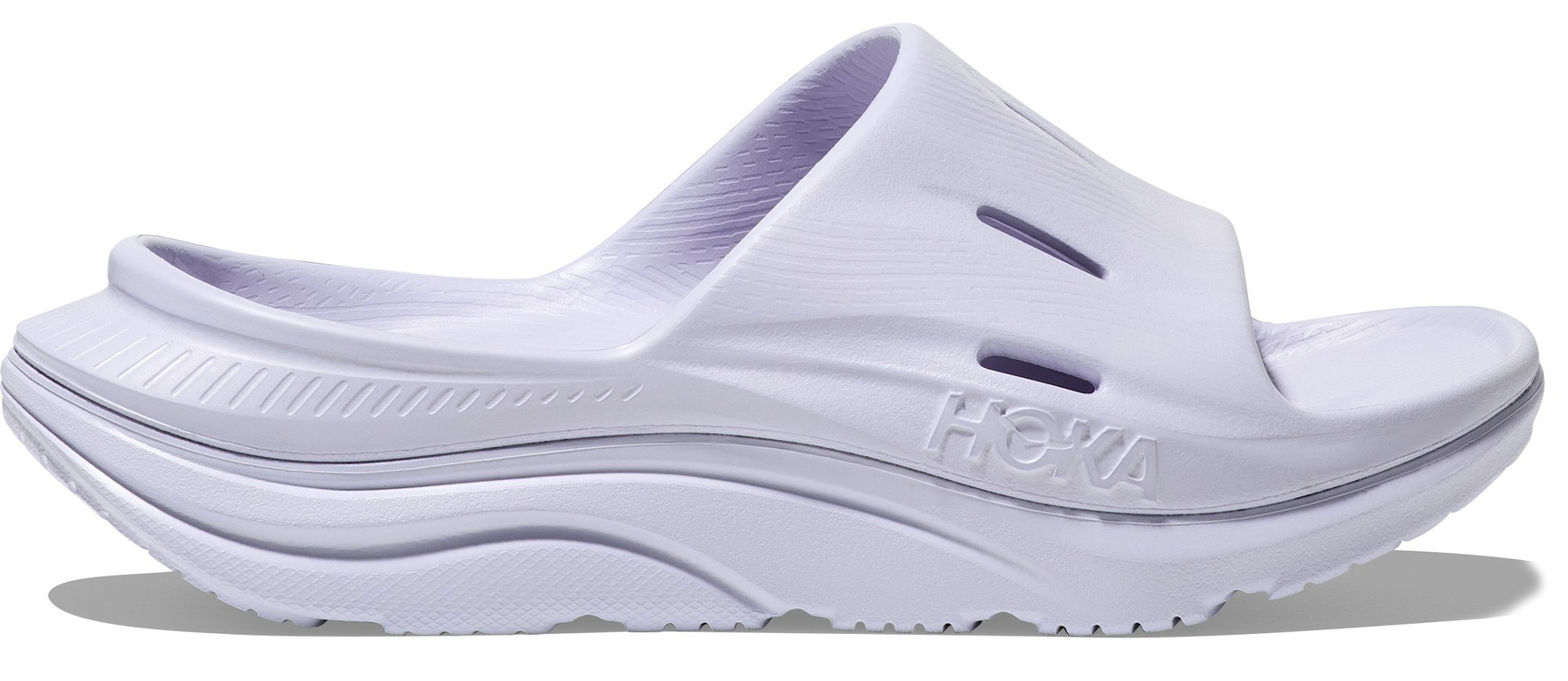 Category: Recovery
Category: Recovery
Closure: None
Weight per pair: 15.6 oz.
What we like: Thick cushioning does a great job absorbing impacts.
What we don’t: Rim at the back causes discomfort for some; heavier than the Oofos Ooahh Slide above.
Oofos’ Ooahh Slide above is our favorite recovery design, but Hoka’s Ora Recovery Slide 3 was close behind in our testing. Like the Oofos, the Hoka shoes are generously padded with plush foam that does a great job absorbing impacts, along with a rockered profile to minimize stress on your joints and promote a smooth, natural gait. We also like the bright selection of colorways, from basic black and grey to bright pink and purple (there are even a few two-tone options). A final feather in the Hoka’s cap is its sugarcane-based footbed, which gives the shoe a stronger sustainability slant than the Ooahh Slide. And if you’re looking for something different, the Ora is sold in a flip-flop version for the same price, a Luxe model with adjustable straps, and a Mule variation that resembles the Crocs above but without a heel strap.
As we mentioned, it was a close call deciding between the Oofos Ooahh Slide above and Hoka Ora Recovery 3 here as our favorite recovery design, but the Oofos proved to be more well rounded in our testing. While both shoes have a slightly tippy feel due to their generous cushioning and rockered profile, the Oofos is a little less pronounced than the Hoka, leading to better stability. It’s also lighter by 6 ounces per pair and lacks the Hoka’s raised section of foam at the back of the heel, which may cause discomfort for some. A final distinction is that the Oofos shoes run on the narrower end, while some note that the Ora Recovery Slides are too wide (both shoes fit our average-footed tester just fine). In the end, a final decision may come down to which shoe fits your foot best, but we’re big fans of Hoka’s max-cushioned designs.
See the Hoka Ora Recovery Slide 3
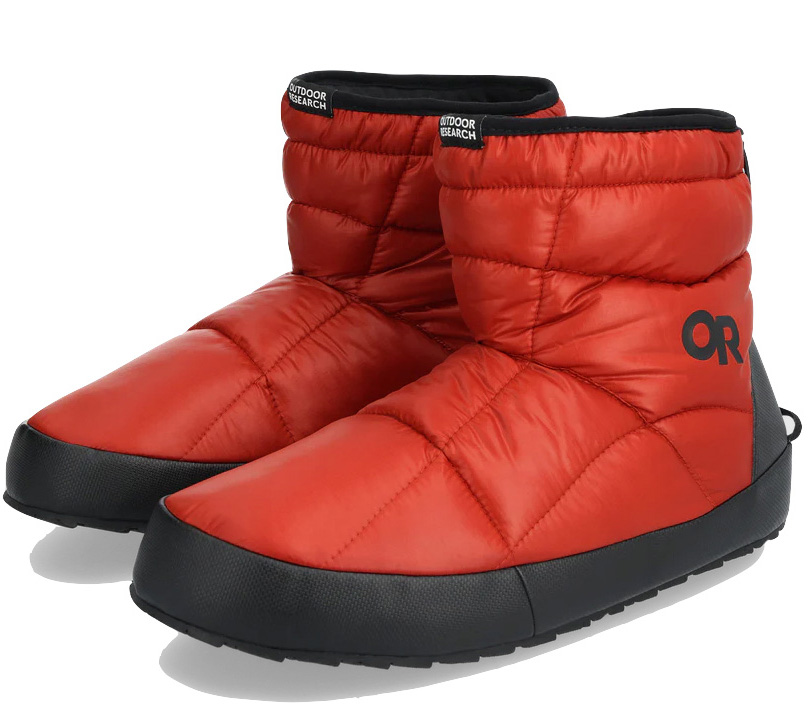 Category: Bootie
Category: Bootie
Closure: Drawcord (cuff)
Weight per pair: 1 lb. 3.7 oz.
What we like: Better traction and protection than the Feathered Friends booties above for less.
What we don’t: Not as warm or durable.
Joining Feathered Friends’ Down Booties above is another over-the-ankle design we love: Outdoor Research’s Tundra Trax Booties. In this case, OR opted for synthetic rather than down insulation, which saves you a bit of cash while improving wet-weather performance (unlike down, synthetic fill will continue to insulate when wet). You also get a handy drawcord for cinching the cuff opening, a Pertex Quantum shell that does a good job fending off light to moderate moisture, and a tricot lining that makes it easy to slip your feet inside with or without socks. Added up, the Tundra Trax is a great cold-weather companion whether you’re lounging around the cabin or enjoying a post-ski brew at the lodge.
It’s worth noting that we also tested the Tundra Trax Slip-On Booties, which will save you $10 and 3.3 ounces in weight compared to the taller model here. However, while very similar in appearance to The North Face’s Traction Mules above, the OR slip-ons offered noticeably less security—the slippery interior and short, overlapping heel design caused our foot to unexpectedly pop out of the shoes on several occasions. We also got a small snag in the upper after just a couple uses, which isn’t a good sign for long-term durability. The higher-riding booties eliminate the security issues with their over-the-ankle cut but share the same thin fabric, and they're notably less warm than the down-insulated Feathered Friends booties above. On the flip side, the OR design is cheaper by $20 and offers better grip and protection (including helpful PU mud guards at the back), earning them a spot on our list this season.
See the Men's OR Tundra Trax Booties See the Women's OR Tundra Trax Booties
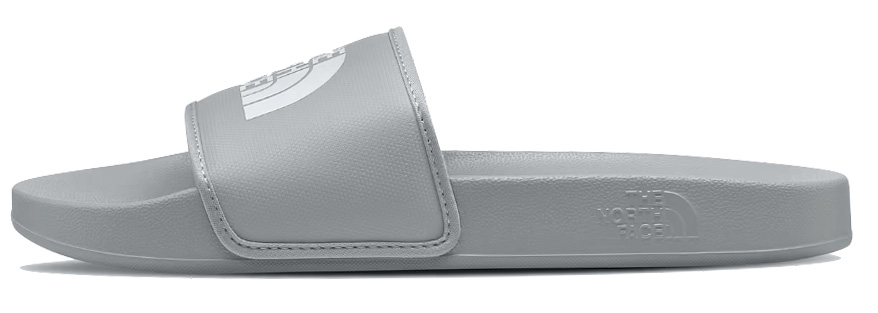 Category: Sandal
Category: Sandal
Closure: None
Weight per pair: 8.7 oz.
What we like: A basic but practical slide that’s light and easy to get on and off.
What we don’t: Apart from value and convenience, they don’t stand out in any major way.
If price and simplicity are high on your priority list, it’s hard to go wrong with The North Face's Base Camp Slides III. At just $39, these kicks are the cheapest option here and will get the job done while you’re whipping up dinner at camp or taking the dog for a quick walk around the block. They’re decidedly basic with a closure-free, slip-on design and an all-foam construction, but the flip side is that they’re incredibly lightweight, decently comfortable, and essentially effortless to get on and off. And did we mention they’re just $39? Even if they only last you a season or two, the Base Camp Slides are a pretty solid value and should outlast the sub-$20, off-brand flip-flops you’ll find scouring Amazon.
Apart from price and convenience, however, we have limited praise for the TNF slides. The sole is very basic and not grippy enough for true outdoor use—it’s fine on packed surfaces and around the house but decidedly underbuilt for navigating any sort of technical terrain. What’s more, we wish TNF had equipped the strap with Velcro for better security, and we’re not big fans of the brand’s logo positioned front and center. But again, if the main goal is to keep costs low and you don’t care all that much about looks or performance, the Base Camp Slides are a cheap option to throw in a duffel bag or the back of your vehicle for weekend camping trips.
See the Men's TNF Base Camp Slides III See the Women's TNF Base Camp Slides III
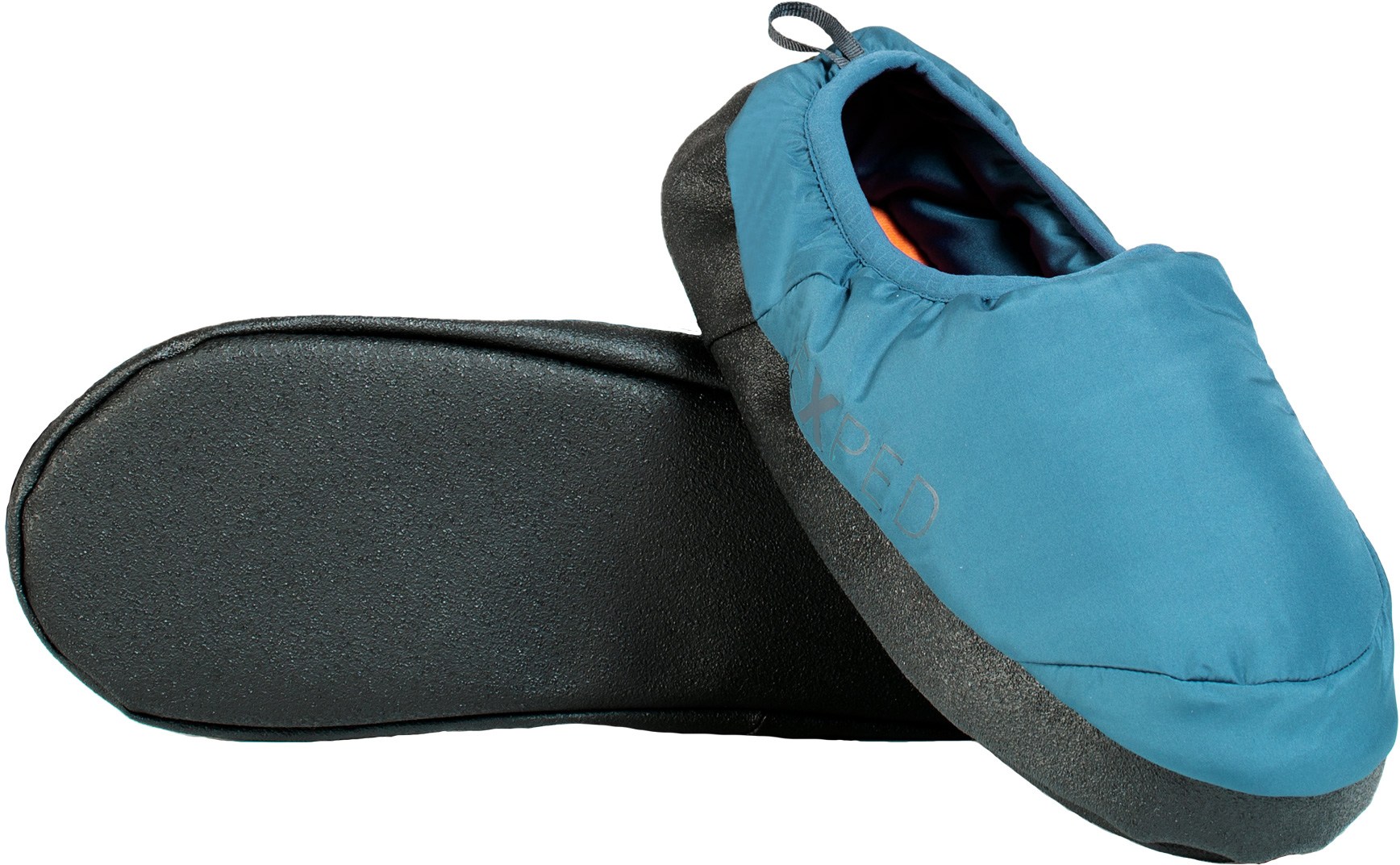 Category: Slipper
Category: Slipper
Closure: None
Weight per pair: 4.8 oz.
What we like: The lightest design on our list and extremely packable.
What we don’t: Relatively thin materials and runs big.
If you’re looking to keep weight low but don’t like the idea of wearing an open-toe design outdoors, Exped’s Camp Slipper fits the bill nicely. At just 4.8 ounces for the pair, these slippers are the lightest shoes on our list, even undercutting low-profile sandals like the Luna Leadville Pacer and Bedrock Cairn Evo above. Importantly, Exped managed to pull this off while retaining full foot coverage and a pretty well-rounded feature set, including a modest amount of foam cushioning and synthetic insulation for warmth, a smooth but tacky TPU outsole, and an elasticized collar to seal out drafts and debris. And when it’s time to pack up camp, the shoes collapse down impressively small or can be secured to the outside of a pack via the attachment loop at the back.
All that said, Exped did need to make some notable concessions to keep weight and bulk to a minimum. Specifically, the sole is relatively thin and provides minimal isolation from rocks and roots underfoot, leading to more of a barefoot feel than what you get with beefier (but heavier) designs like the TNF Traction Mules and Teva ReEmber above. We also have concerns about the upper, which strikes us as susceptible to snags and tears over time (although it’s held up well thus far in testing). Last but not least, sizing runs big, and we advise trying the slippers on before you buy to ensure a good all-around fit. For cold-weather pursuits, Exped also offers the design in a higher-riding Camp Booty ($65) that’s largely similar but with over-the-ankle coverage. And for a small step up in support and structure, we also like Rab’s Cirrus Hut Slipper, which is $10 pricier and 1.3 ounces heavier per pair but slightly more capable.
See the Exped Camp Slipper
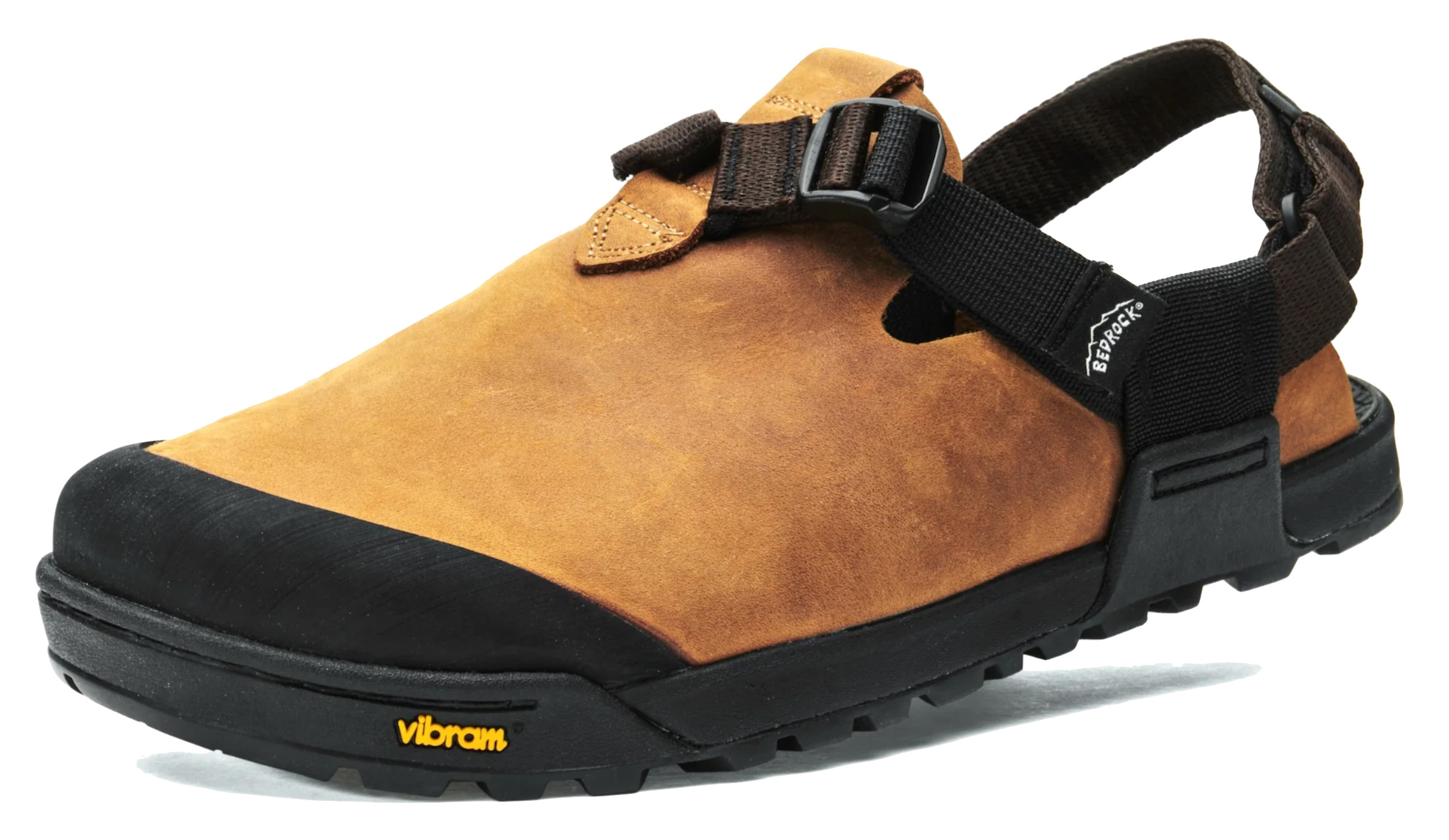 Category: Clog
Category: Clog
Closure: Strap (buckle)
Weight per pair: 1 lb. 9.0 oz.
What we like: Classic mountain aesthetic, excellent grip, and premium leather upper.
What we don’t: Expensive, bulky, and relatively stiff out of the box.
In stark contrast to the Crocs above is Bedrock Sandals’ Mountain Clog, which trades the basic foam construction for premium nubuck leather. The benefits are multifold, including excellent durability and a very supple feel. They do take some time to break in, but that’s not uncommon among leather designs, and the shoes have conformed nicely to our feet over time. Bedrock nailed a similar level of quality with the rest of the design, including a Vibram Megagrip outsole that offers class-leading traction, a molded footbed that provides good all-day comfort and support, and a beefy rubber toe cap that’s reminiscent of what you might find on an approach shoe. We like the heel strap, too, which features adjustment points both over the foot and at the back for fine-tuning fit. Finally, while entirely subjective, we love the classy aesthetic of the Mountain Clog, which wears better around town than many of the other designs here.
While quality is a big selling point of the Mountain Clog, it doesn’t come cheap at $175, making it the priciest option on our list by a decent margin. Bedrock does sell the design in cheaper suede and synthetic suede variations (both $160), the latter of which has a mesh-lined upper for added breathability, but we prefer the high-end look and feel of the nubuck model. All three styles are on the heavier and bulkier end, although the advantages in support, protection, and coverage will be worth those trade-offs for some—whether you’re commuting by bike, going on a short hike, or spending a chilly evening at camp. Note: The Mountain Clog is only offered in full sizes, so you’ll want to take your sock choice into account before buying.
See the Bedrock Sandals Mountain Clog
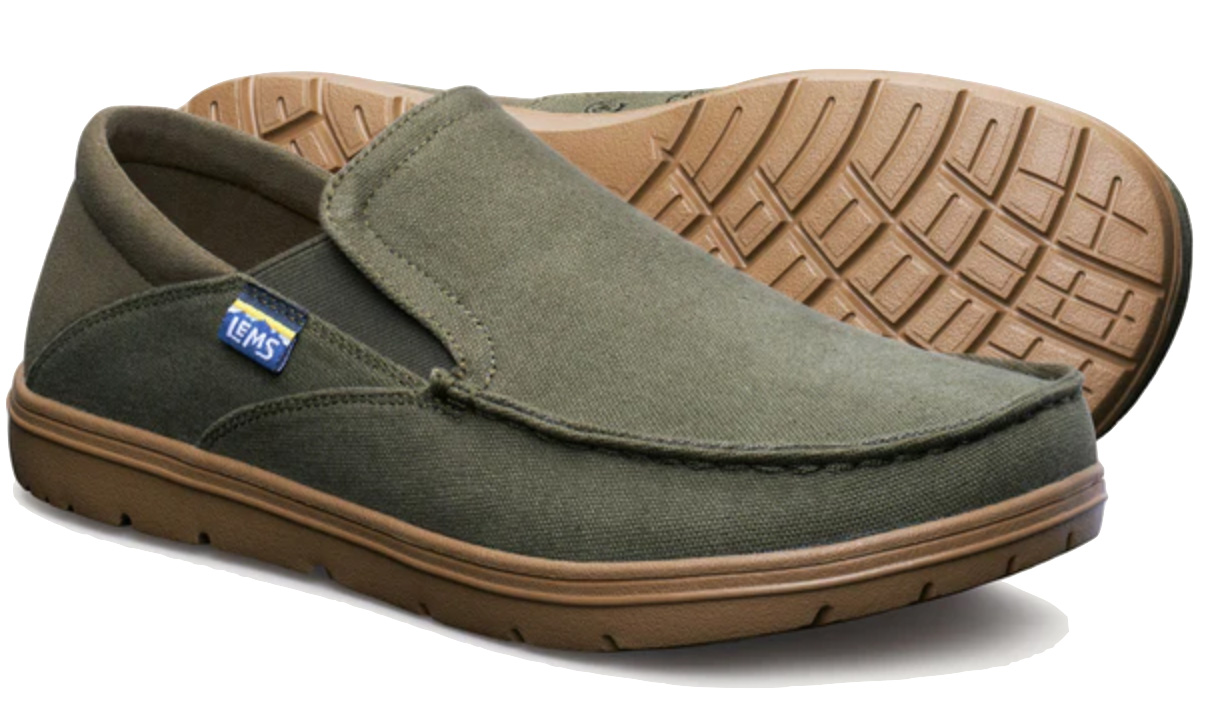 Category: Slipper
Category: Slipper
Closure: None
Weight per pair: 12.0 oz.
What we like: A great everyday shoe that looks the part at camp or around town.
What we don’t: More fashion than function; heel may cause discomfort for some; not the best at sealing out debris.
We’ve worn many of the shoes here around town, but the Lems Drifter is arguably the best suited for the job. With a simple, lace-free design and cotton canvas upper, the Drifter has a very clean and streamlined aesthetic that feels at home in coastal and mountain towns alike. What’s more, comfort is excellent thanks to the stretchy elastic liner and cork insole, which can be removed for a more minimalist feel or when paired with thicker socks. Like the Traction Mules and ReEmber slippers above, the Lems also features a collapsible heel that allows you to simply slip your feet inside and leave the back open or extend it over your heel for added security. Rounding out the build is a thick rubber outsole that’s not particularly aggressive but plenty grippy for everyday wear and light outdoor use.
All that said, calling the Lems Drifter a “camp shoe” is a bit of a stretch. While we’ve brought the shoes on several camping trips, we’ve found ourselves reaching for them far more often at home—while running errands around town, picking up the kids from school, walking the dog around the block, etc. Further, some users report discomfort from the heel digging into the back of the ankle, but our average-footed tester didn’t experience any issues. A final complaint is that the collar dips down fairly aggressively at the sides, making it easy for debris like gravel and sand to enter. But for around-town use and the occasional camping trip, the Lems Drifter is a stylish and well-built option with a lot of daily appeal.
See the Men's Lems Drifter See the Women's Lems Drifter
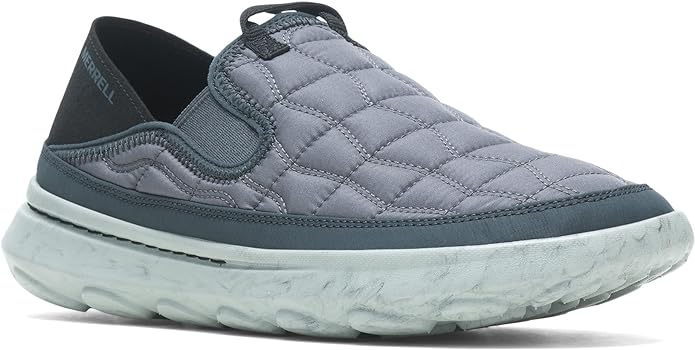 Category: Slipper
Category: Slipper
Closure: None
Weight per pair: 11.3 oz.
What we like: Competitively light and does a nice job isolating your foot from the ground.
What we don’t: Foam outsole may wear down quickly; not the plushest slipper here.
Merrell makes some of our favorite hiking boots and shoes, so it comes as no surprise that they make a solid camp shoe, too. From their well-rounded lineup, the Hut Moc 2 stands out for its lightweight build and versatile styling. In terms of construction, we think Merrell nailed the details with a quilted nylon upper that holds up well over time and looks the part both outdoors and around town, especially in the darker colorways. The shoes are also very easy to get on and off thanks to the collapsible heel, generous pull tab, and stretchy panel at either side of the foot. Rounding out the build is an effective anti-odor treatment and thick and springy foam midsole that does a good job isolating your foot from the ground.
One area of concern with the Merrell Hut Moc 2 is the EVA foam outsole, which helps keep weight low but isn’t very confidence-inspiring for outdoor use. To be fair, the Hut Moc makes for a great around-the-house slipper and can easily pull double duty on the occasional camping trip, but we’d recommend steering clear of rocks and other sharp objects to avoid punctures. In our experience, slippers with rubber outsoles—like the TNF Traction Mules V and Teva ReEmber Slip-Ons above—are much more outdoor-ready, although the Merrell is the lightest of that bunch by a decent margin. If you’re looking for something a little different, Merrell’s Hut Moc collection also includes the Hut Moc 2 Quilted Slide and Hut Moc 2 Packable, the latter of which features a unique wraparound zipper for connecting the pair and attaching them to a pack via the included carabiner.
See the Men's Merrell Hut Moc 2 See the Women's Merrell Hut Moc 2
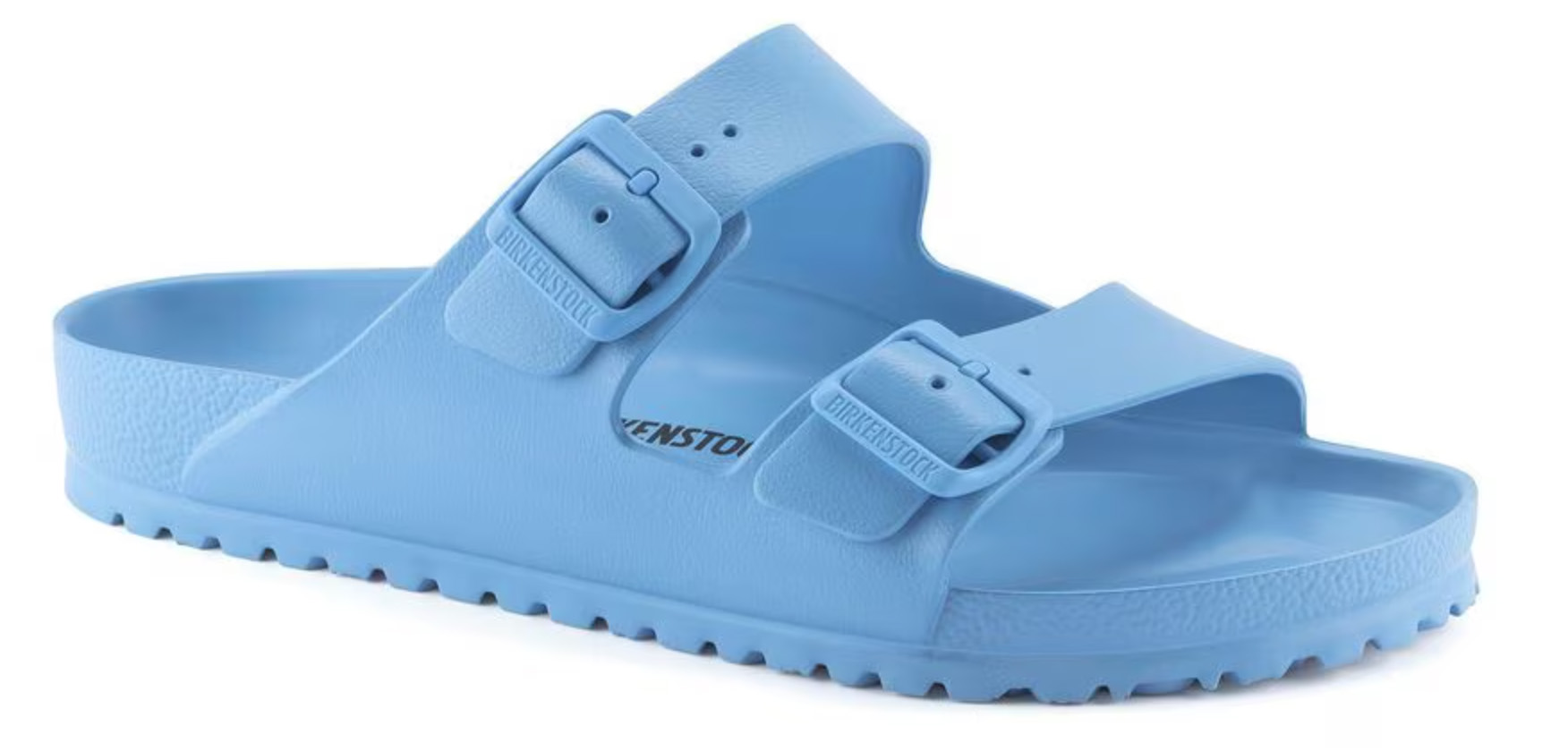 Category: Sandal
Category: Sandal
Closure: Strap (buckle)
What we like: Classic Birkenstock styling in a light and easy-to-clean package.
What we don’t: Stiff and plasticky feel out of the box, although they do break in over time.
Birkenstocks are a bit of a status symbol among outdoor enthusiasts, but the flagship leather model is pricey and underbuilt for wearing on outdoor adventures. Enter the Arizona Essentials EVA sandal, which costs just $50 (for reference, the leather Arizona models cost around $130 to $145) and swaps the leather upper for a cheaper and lighter EVA foam build. The slip-on design is decidedly basic and lacking in features, but the wide assortment of colorways—from Candy Pink and Faded Lime to classic black and white—and cheap price tag make it an excellent and stylish option for around-town wear, afternoons by the water, and hanging around camp after long days on the trail.
Trying the Arizona Essentials EVA sandals on for the first time, we were unimpressed by their plasticky and unforgiving feel—even compared to other all-foam designs like the Crocs Classic Clog above. To be fair, they’ve loosened up a decent amount over time, but the lack of flexibility makes them less ideal than alternatives like the Luna Leadville Pacer above for stashing in a full backpacking pack. Additionally, the lack of rear strap limits the Arizona to easy terrain when you don’t need your heel locked down (although the upside is that they’re incredibly quick to get on and off and easy to pair with thick socks on cooler days). But as an everyday staple and backup pair of footwear to wear after you’ve reached the crag or campsite, the value is hard to beat.
See the Men's Birkenstock Arizona Essentials EVA See Women's Arizona Essentials EVA
| Camp Shoe | Price | Category | Closure | Weight (Pair) | Insulation |
|---|---|---|---|---|---|
| TNF ThermoBall Traction Mules | $59 | Slipper | None | 1 lb. 0.3 oz. | Synthetic |
| Crocs Classic Clog | $50 | Clog | None | 14.0 oz. | None |
| Chaco Z/Cloud | $105 | Sandal | Strap (buckle) | 1 lb. 14.1. oz. | None |
| Feathered Friends Down Booties | $119 | Bootie | Drawcords (ankle/cuff) | 9.3 oz. | 800-fill down |
| Luna Sandals Leadville Pacer | $120 | Sandal | Strap (buckle/Velcro) | 8.9 oz. | None |
| Oofos Ooahh Slide | $60 | Recovery | None | 9.6 oz. | None |
| Teva ReEmber Slip-Ons | $80 | Slipper | None | 1 lb. 2.0 oz. | None (poly lining) |
| Bedrock Sandals Cairn Evo | $115 | Sandal | Strap (buckle/Velcro) | 15.6 oz. | None |
| Keen Howser III Slide | $100 | Slipper | Drawcord (cuff) | 1 lb. 7.4 oz. | None (fleece lining) |
| Hoka Ora Recovery Slide 3 | $60 | Recovery | None | 15.6 oz. | None |
| OR Tundra Trax Booties | $99 | Bootie | Drawcord (cuff) | 1 lb. 3.7 oz. | Synthetic |
| TNF Base Camp Slides III | $39 | Sandal | None | 8.7 oz. | None |
| Exped Camp Slipper | $55 | Slipper | None | 4.8 oz. | Synthetic |
| Bedrock Mountain Clog | $175 | Clog | Strap (buckle) | 1 lb. 9.0 oz. | None |
| Lems Drifter | $95 | Slipper | None | 12.0 oz. | None |
| Merrell Hut Moc 2 | $75 | Slipper | None | 11.3 oz. | None |
| Birkenstock Arizona Essentials | $50 | Sandal | Strap (buckle) | Unavailable | None |
As reviewers of outdoor gear, we spend a lot of time outside and are always looking for ways to keep our feet happy—whether we’re spending long days on the trail or venturing up rock faces with our toes jammed inside tight climbing shoes. To complement our other footwear reviews, managing editor Sarah Nelson kicked off this guide in 2024. Previously based out of a converted cargo van, Sarah is always on the hunt for gear that will keep her cozy and stand up well to frequent outdoor use. While she’s worn many of the options above, her go-to camp shoes are the Teva ReEmber Slip-Ons, which have accompanied her on everything from errands around town to shoulder-season bouldering sessions—in fact, she wore them while writing this guide.
Prior to publishing this round-up, Sarah and a couple of her coworkers took eight pairs of camp shoes to Washington for testing, where they evaluated performance while camping and backpacking in the Alpine Lakes Wilderness. Since then, our team has continued to test camp shoes near and far—from local outings in the Pacific Northwest and Lake Tahoe area to far-flung adventures in Patagonia. In landing on our 17 favorites above, we took several factors into account, with comfort and easy on/off being two of our biggest considerations. Depending on your objectives and intended uses, characteristics like weight, support, warmth, protection, and traction may or may not be high on your priority list, so we included a wide range of options above, from minimalist sandals to cold weather-ready booties. Be sure to check back in regularly, as the list above will continue to change to reflect our current favorites and new innovations in the market.
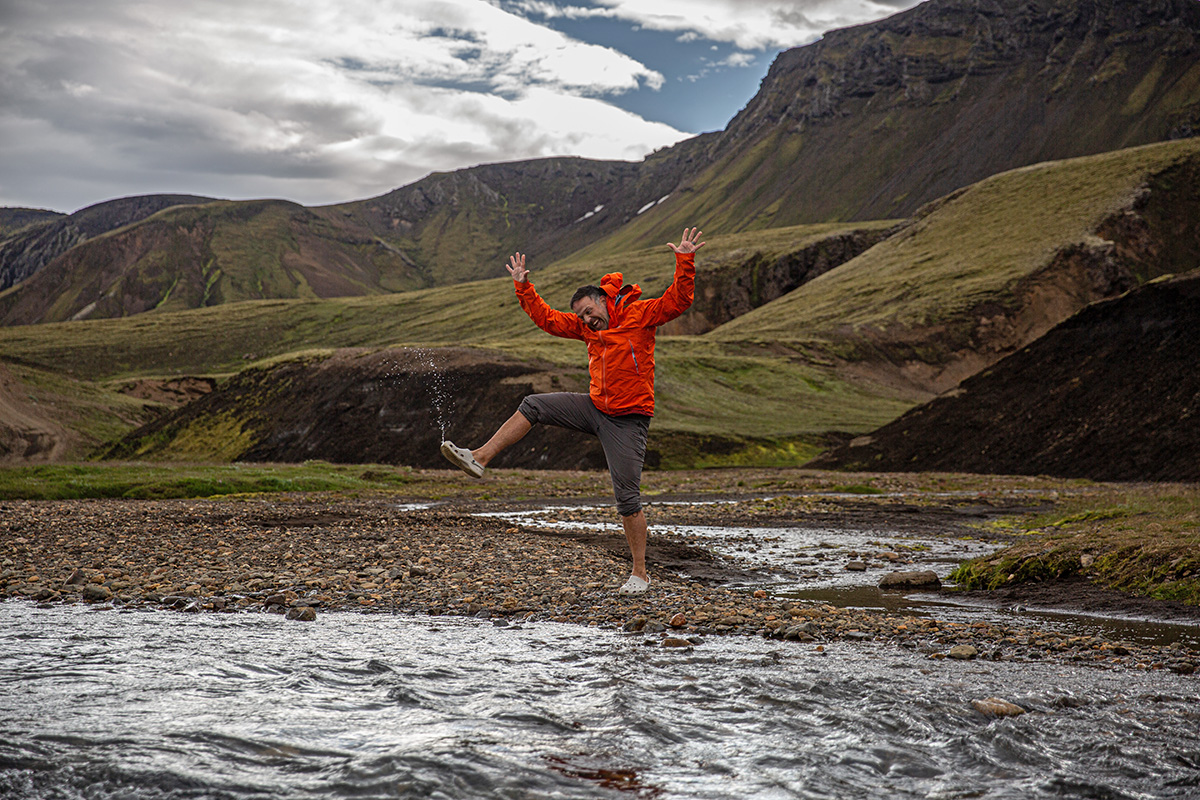
Camp shoes are designed to give your feet a break after long days outside—whether they’ve been crammed in hiking boots, ski boots, or climbing shoes. The category has a very wide scope, comprising everything from plush slippers for car camping and lounging around the cabin to ultralight sandals for toting into the backcountry. Recovery shoes are also becoming increasingly popular among endurance athletes like runners looking to give their feet a break after big efforts. The style you choose will largely depend on your intended use(s), but all camp shoes share a few basic characteristics: easy on and off, materials that are built to withstand the rigors of outdoor use, and enough support and structure for quick outings from camp or running errands around town (at the very least). Sure, a cheap pair of flip-flops may suffice for a season or two, but we’ve had countless pairs fall apart on us over the years and think the added investment is well worth it for folks who spend a lot of time outside and want something that will last.
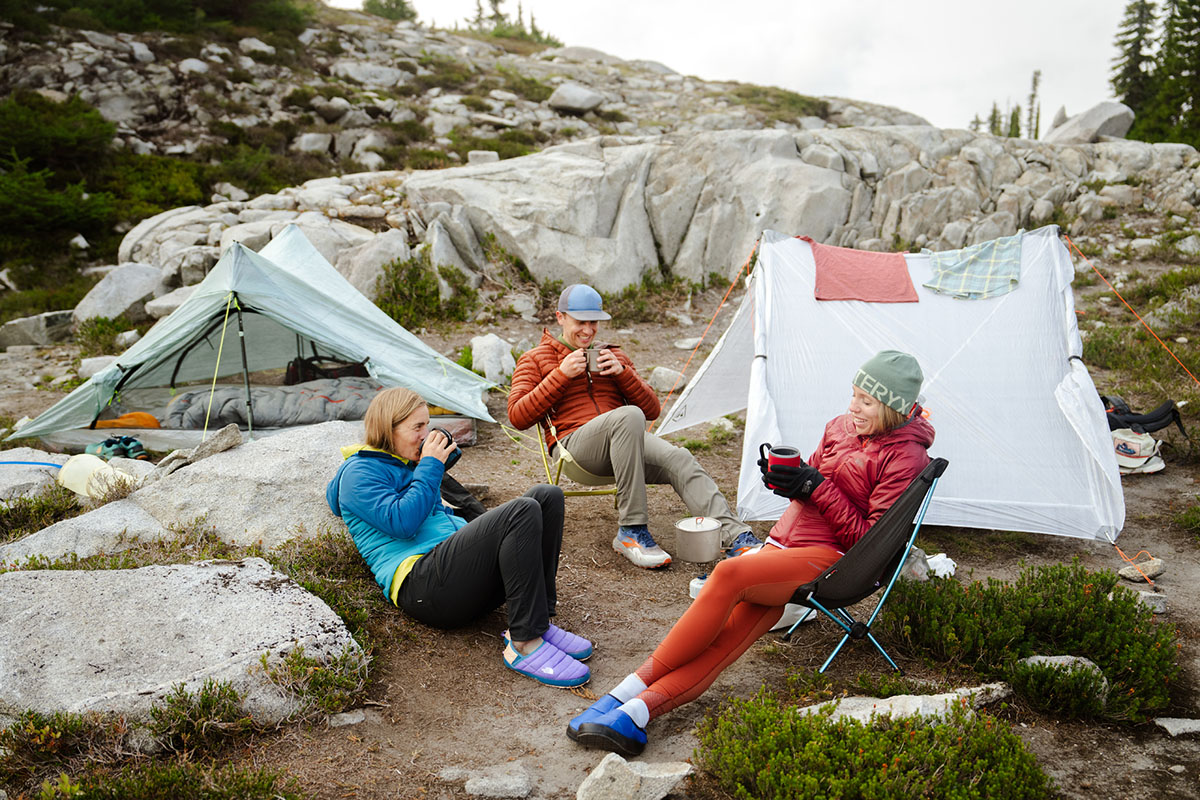
Since this is such a broad category, we’ve broken our picks down into several subcategories to help you narrow down your search: slippers, booties, sandals, recovery shoes, and clogs. Below we break down the pros and cons of each style, including who and what each type is best for, common features and characteristics, and more. Depending on your objectives and how much time you spend outside, you may end up having more than one option in your closet.
Slippers
We love a good pair of camp slippers, whether we’re whipping up dinner at a campground, working from home, or cozying up with a good book in our van. Two of our favorites in this category are The North Face’s Traction Mules V and Teva’s ReEmber Slip-Ons, both of which are high on comfort, look great whether in the outdoors or around town (the Tevas are a little better suited for everyday use), and are very easy to get on and off—simply slide your foot inside (with or without socks) and either leave the heel collapsed or use your thumb to secure it over the back of your foot. We also like Keen's Howser III Slide and Exped’s Camp Slipper, although the Keens are relatively heavy and don’t have a collapsible heel, while the Exped slippers use relatively thin materials to keep weight low (they’re a nice option to throw in a pack for backpacking adventures).
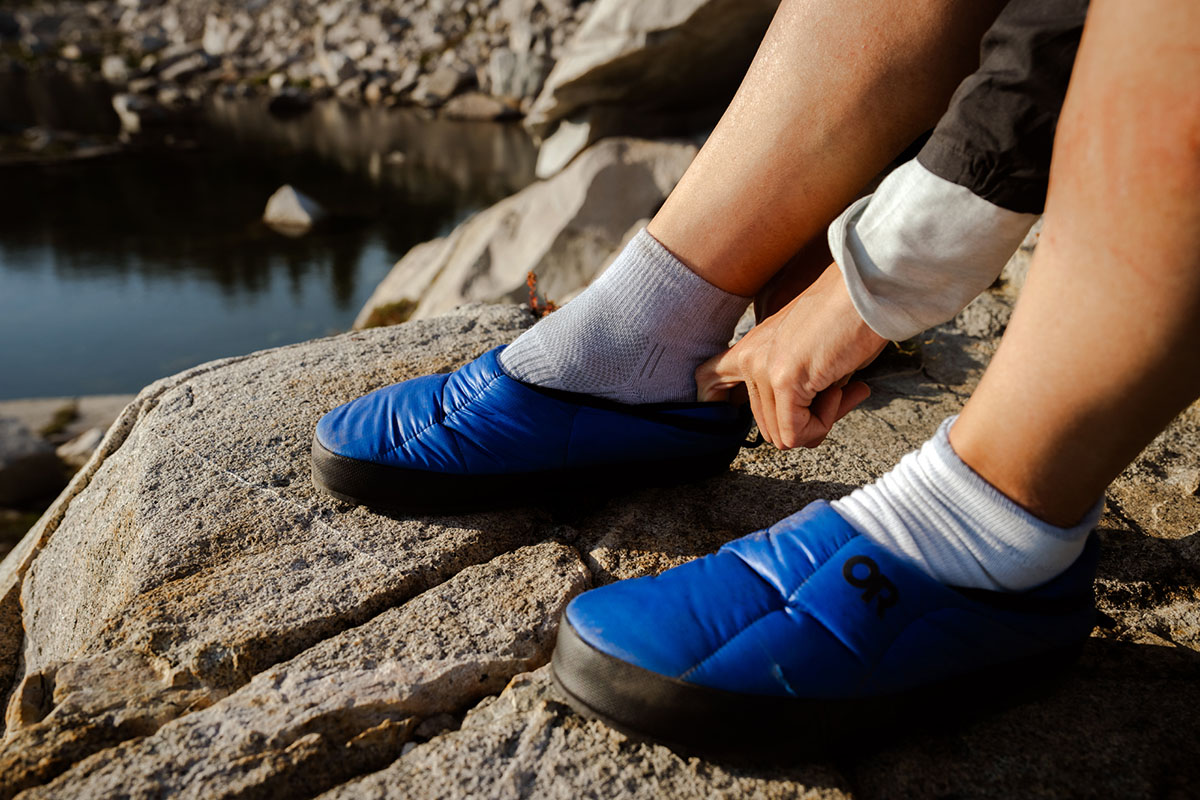
Booties
Similar to slippers but with a higher-riding collar, booties are a staff favorite for cold-weather adventures that warrant added coverage. We included two booties on our list: the Feathered Friends Down Booties and Outdoor Research Tundra Trax Booties, both of which extend over the ankle and feature drawcord closures at the cuff for sealing out wind and moisture (the Feathered Friends shoes have an additional drawcord at the ankle). Many of the slippers on our list are also sold in bootie versions, including the TNF Traction Mules, Teva ReEmber, and Exped Camp Slipper. Compared to slippers, booties are harder to get on and off due to the added height and material, often requiring two hands to pull on, with the biggest draws being added warmth and coverage in cold environments. We typically don’t wear booties outside of the winter months, but they can be a nice option for hut trips, après ski, and winter camping—just don’t expect them to replace a pair of winter boots.
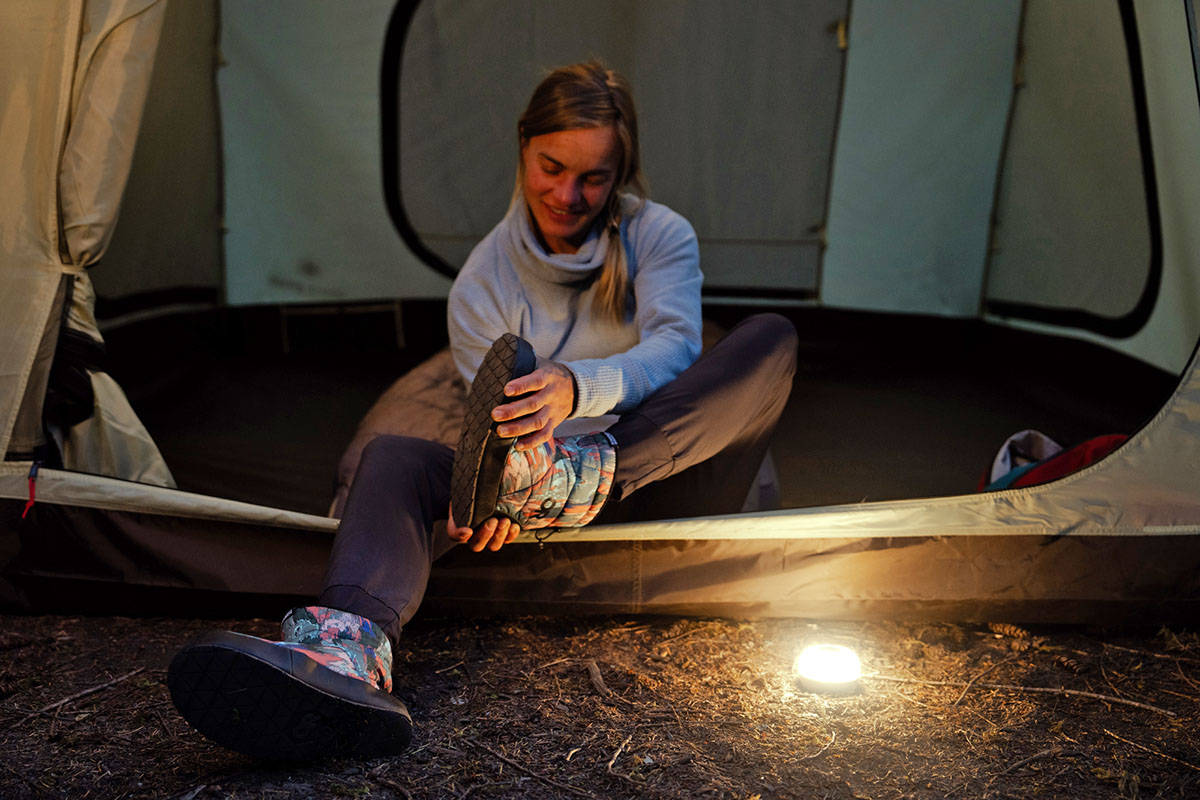
Sandals
For summertime hiking and trips into the backcountry, we turn to open-toe sandals. In addition to being lower-profile than closed-toe designs, sandals are inherently more breathable and less prone to stink buildup. Many are also impressively light and packable, which is great news for weight-conscious backpackers looking to keep heft and bulk to a minimum. Chaco’s Z/Cloud above is our favorite sandal for wearing around camp and casually in the summer months, but it’s heavy at nearly 2 pounds and bulky enough that we typically leave it behind on backpacking trips. On the flip side, minimalist options like Luna’s Leadville Pacer and Bedrock’s Cairn Evo are competitively light and flexible—great for strapping to the outside of a pack and giving your feet a break after long days on the trail. The Chacos offer far better structure and support for covering long distances, but there’s a reason that designs from Luna and Bedrock have such a loyal following. For a wider look at the market, check out our article on the best hiking sandals.
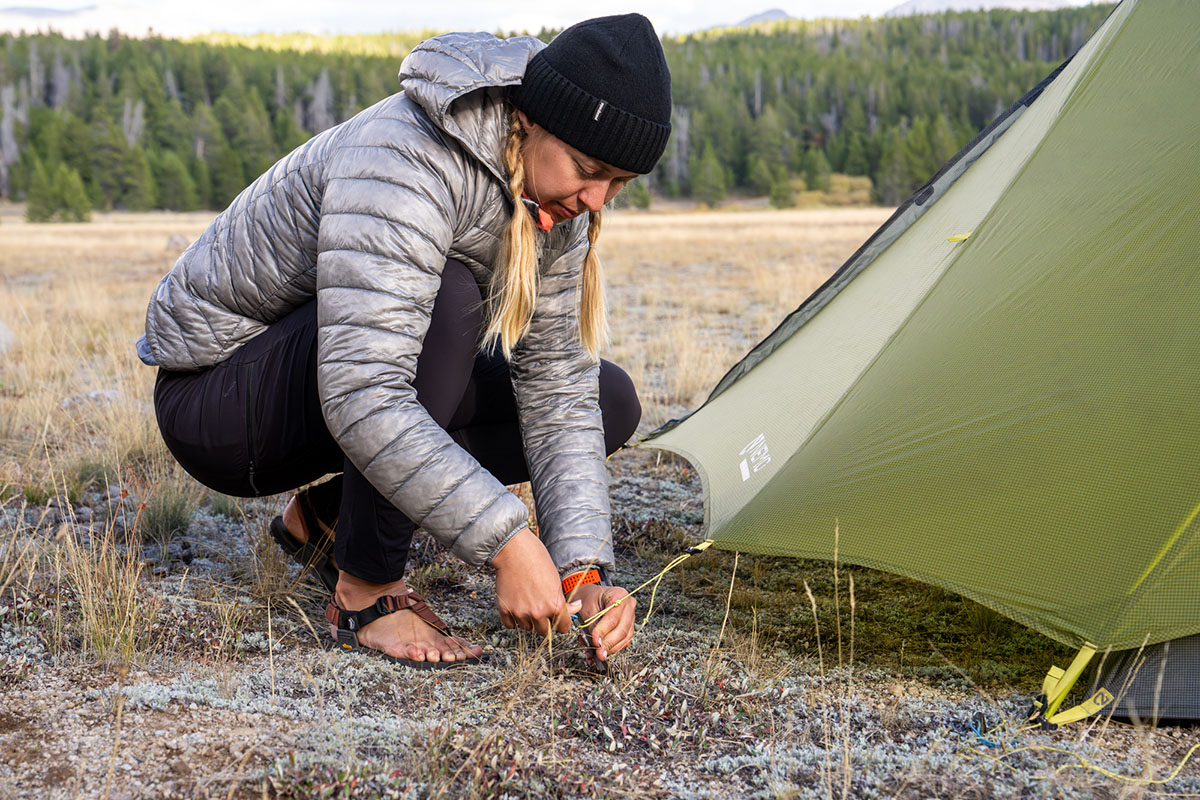
Recovery Shoes
As their name suggests, recovery shoes are designed to give your feet a break after big efforts like long-distance runs or multi-pitch climbs. They can also be helpful for those who suffer from issues like plantar fasciitis or rheumatoid arthritis. While styles vary widely, all recovery shoes prioritize comfort with thick padding and generous support. Our two favorites in this category are the Oofos Ooahh Slide and Hoka Ora Recovery Slide 3, both of which offer a cushy ride and are very easy to get on and off. If you prefer a closed-toe design, both Oofos and Hoka have several offerings to choose from, including clogs, mules, and fully enclosed shoes. No matter which style you go with, keep in mind that recovery shoes have a pretty polarizing feel due to their thick padding and rockered (read: upturned) shape, which is great for impact absorption and minimizing stress on your joints but can result in a tippy and off-balance feel. For this reason, we only wear recovery shoes when our feet are in serious need of some TLC.
Clogs
A final style to consider is the clog, which features front-of-the-foot coverage but leaves most of the heel exposed. We included two clogs on our list, the Crocs Classic Clog and Bedrock Mountain Clog, which lie at opposite ends of the spectrum in terms of price and overall construction. While the Crocs boast an all-foam build that’s cheap, light, and quick to dry, the Bedrock is made with premium nubuck leather and a proven Vibram outsole to maximize longevity and grip, respectively. Both shoes are very easy to slip on and off (although you may have to reach down to deploy or adjust the heel strap) and easy to pair with socks due to their wide and accommodating shapes. Some may find the clog styling to be polarizing, but it’s largely a matter of personal preference.
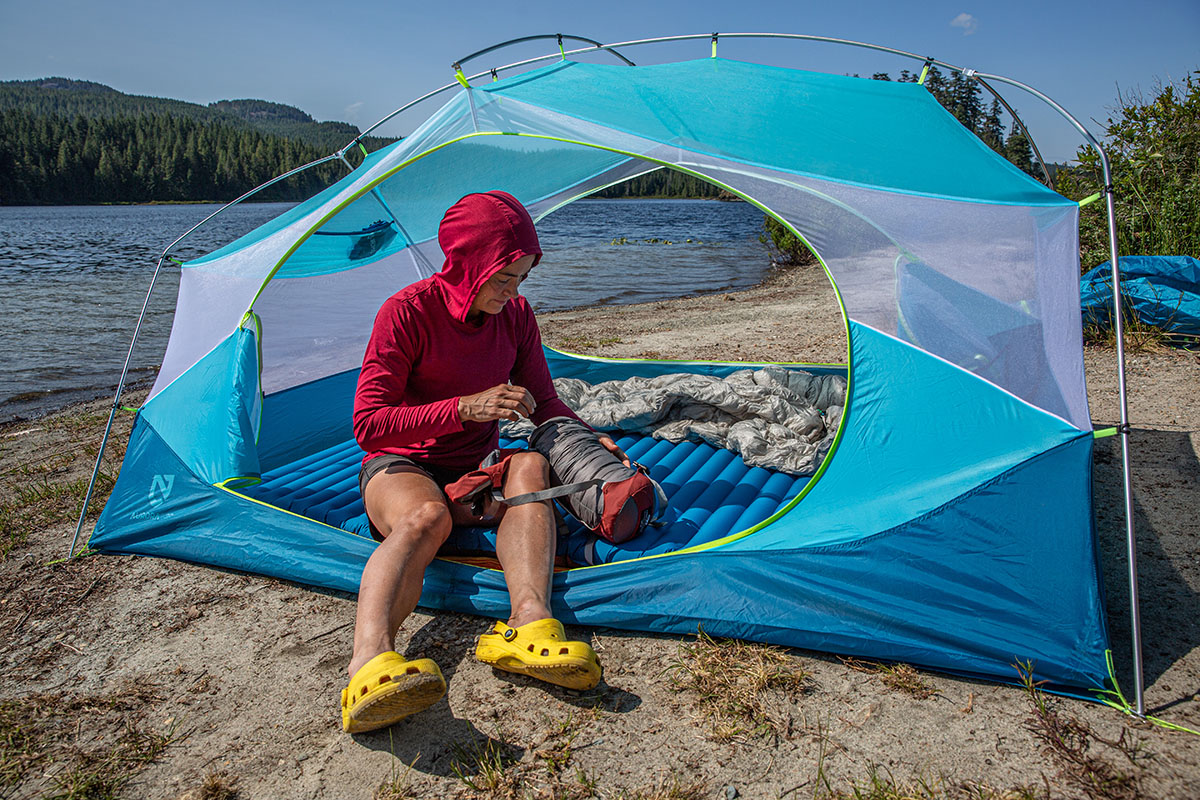
Comfort was one of our top priorities in deciding on our favorite camp shoes, and many of the options above are downright plush. A couple top performers include The North Face’s Traction Mules and Keen's Howser III Slide, both of which are lined with cozy fleece. While decidedly less luxurious, many folks also find Crocs’ Classic Clogs very comfortable due to their forgiving foam build and generous shape, although they take some time to break in. The level of cushioning also plays a role in comfort, with recovery shoes like the Oofos Ooahh Slide and Hoka Ora Recovery 3 offering generous padding underfoot to maximize impact absorption and minimize stress on your joints. Minimalist sandals like the Luna Leadville Pacer and Bedrock Cairn Evo fall toward the less comfortable end of the spectrum but nevertheless are a very welcome reprieve from traditional hiking boots or shoes on high mileage days. In other words, comfort is the result of myriad factors, and only you can decide how much you need.
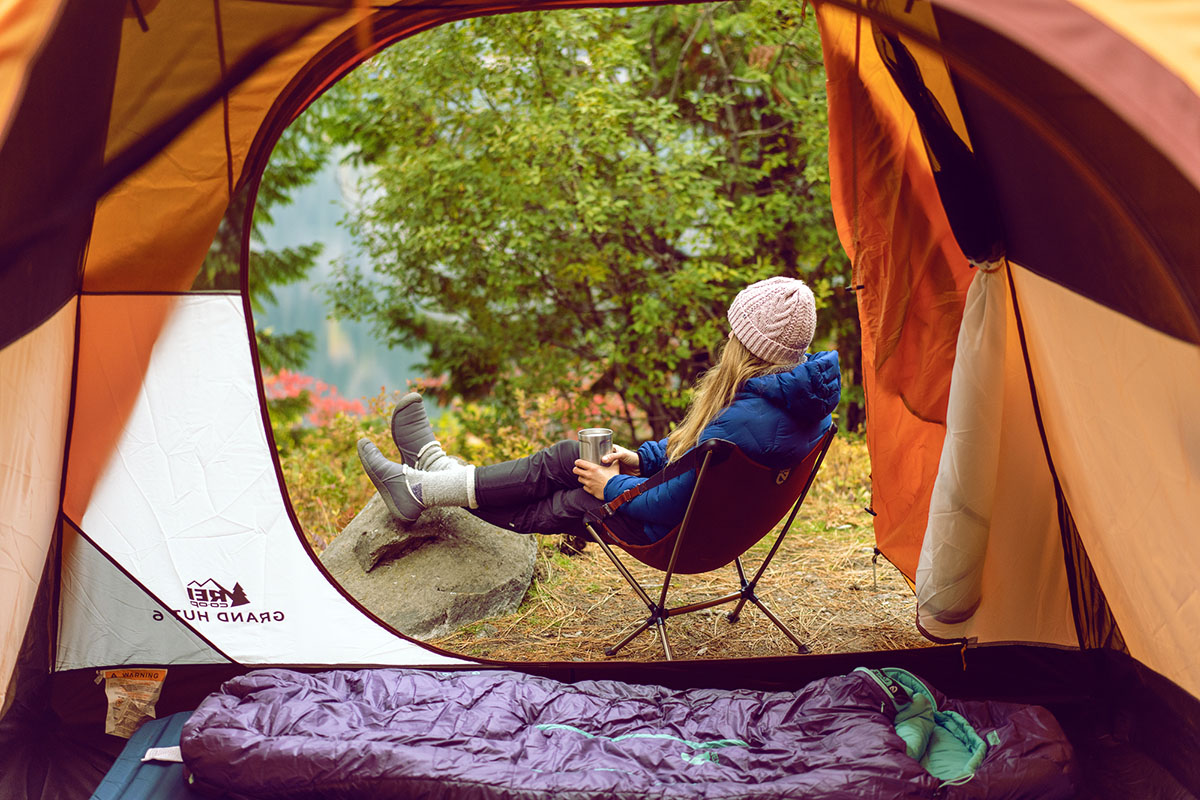
Closure systems vary considerably from shoe to shoe, but easy on and off was a key consideration in choosing our picks above. For the quickest solution, basic slides like The North Face Base Camp III, Oofos Ooahh, and Hoka Ora Recovery 3 require virtually zero effort to slip on and off, with the biggest trade-off being a lack of security. Slippers like The North Face Traction Mules and Teva ReEmber are also very simple, although securing the heel is an added step, as is pairing them with socks. Booties, on the other hand, often require two hands to get on due to their high collar, and then there’s the matter of cinching the drawcord(s), which isn’t necessary but can help maximize warmth and minimize unwanted movement inside the shoes.
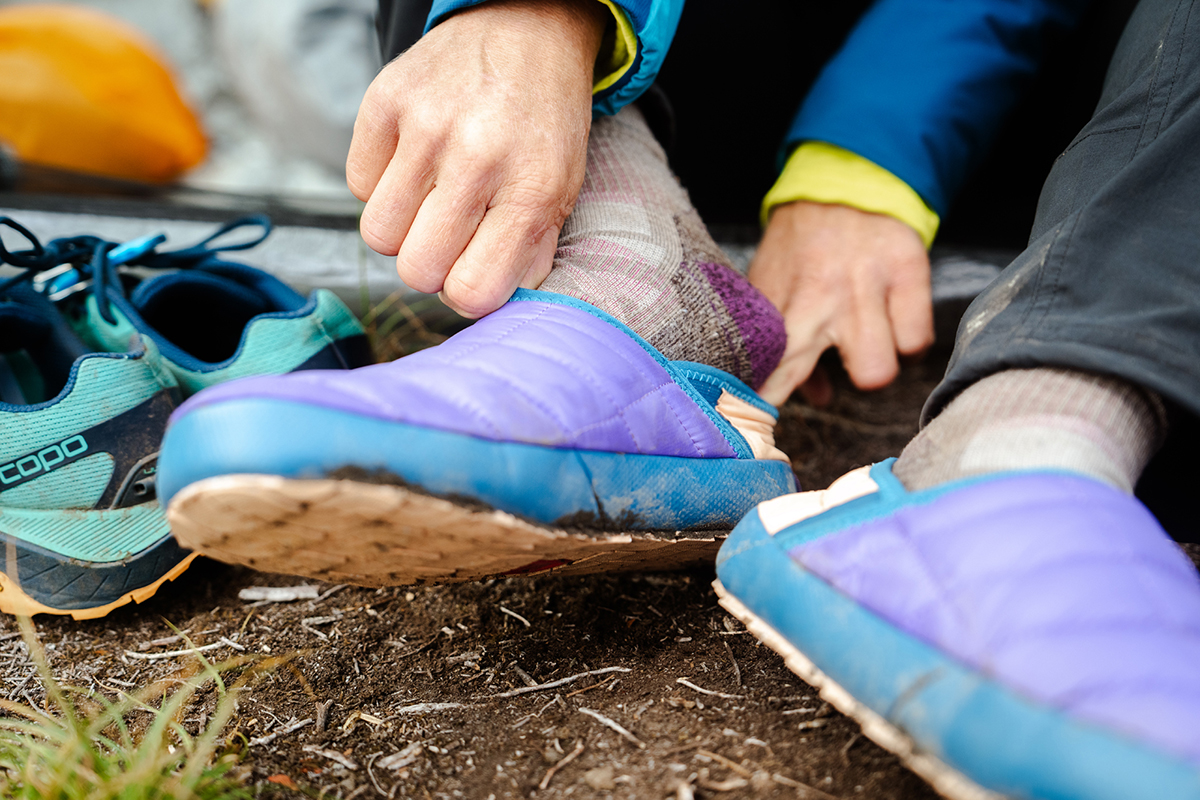
Buckles also complicate the on-and-off process, with sandals like the Chaco Z/Cloud and Bedrock Cairn Evo requiring adjustments each time you put them on. This is rarely a problem on backcountry trips when we’ll do just about anything to give our feet a break from our hiking boots, but it’s less ideal for everyday and casual use when convenience is the top priority. Before buying, it will be helpful to consider the level of security you need, how frequently you plan to take your shoes on and off, and how hard you are on your gear (more moving parts means more pieces that can break or fail over time).
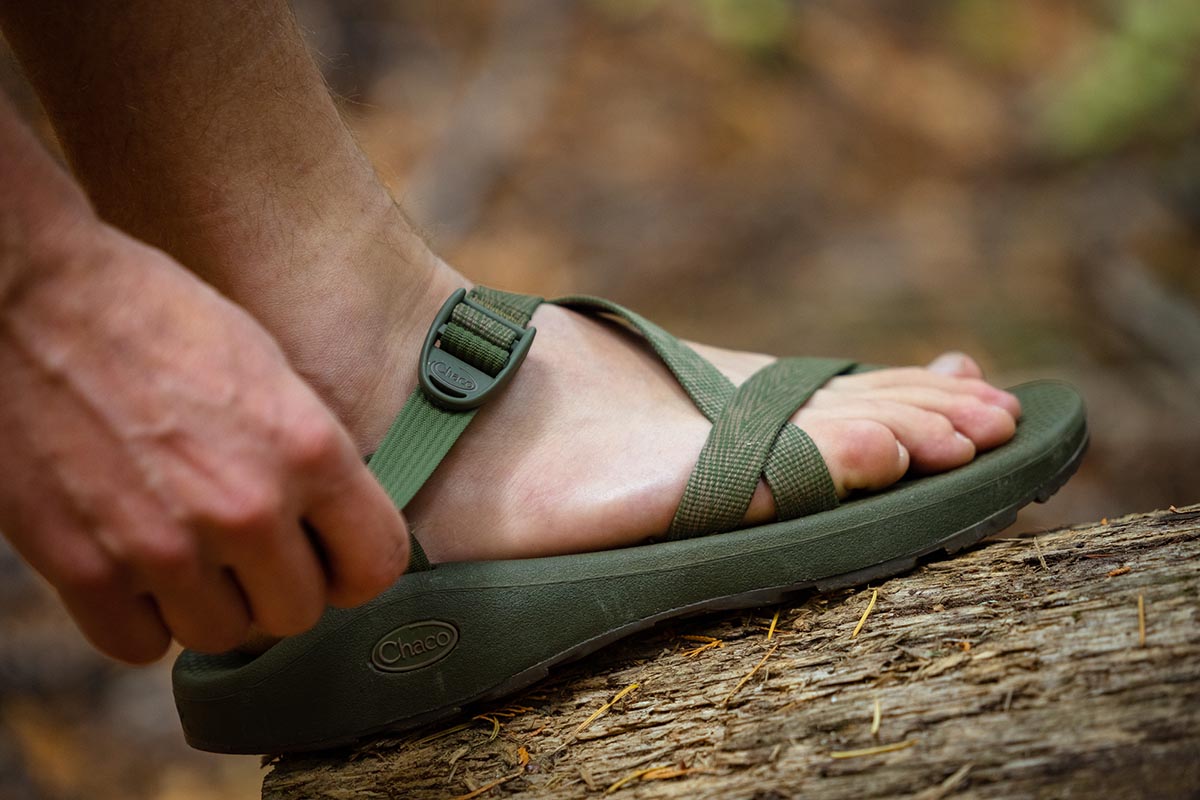
Given the wide spread in camp shoe designs, it’s no surprise that weight varies significantly, with our picks above ranging from just 4.8 ounces per pair (for the Exped Camp Slipper) up to nearly 2 pounds. Most slippers and booties check in toward the heavier end due to their full-coverage uppers, while sandals are typically lighter and more packable. However, there are some notable exceptions to this rule: Chaco’s Z/Cloud sandals, for instance, are the heaviest option on our list at 1 pound 14.1 ounces per pair, while Exped’s Camp Slipper checks in at a scant 4.8 ounces and collapses down impressively small for stashing in a pack. Weight and packability may or may not be an important consideration depending on your intended use(s) and objectives, but those headed deep into the backcountry will benefit from keeping heft and bulk to a minimum. For general camp use and wearing casually, we think designs like Teva’s ReEmber (1 b. 2 oz.) and Lems' Drifter (12 oz.) strike a nice middle ground.
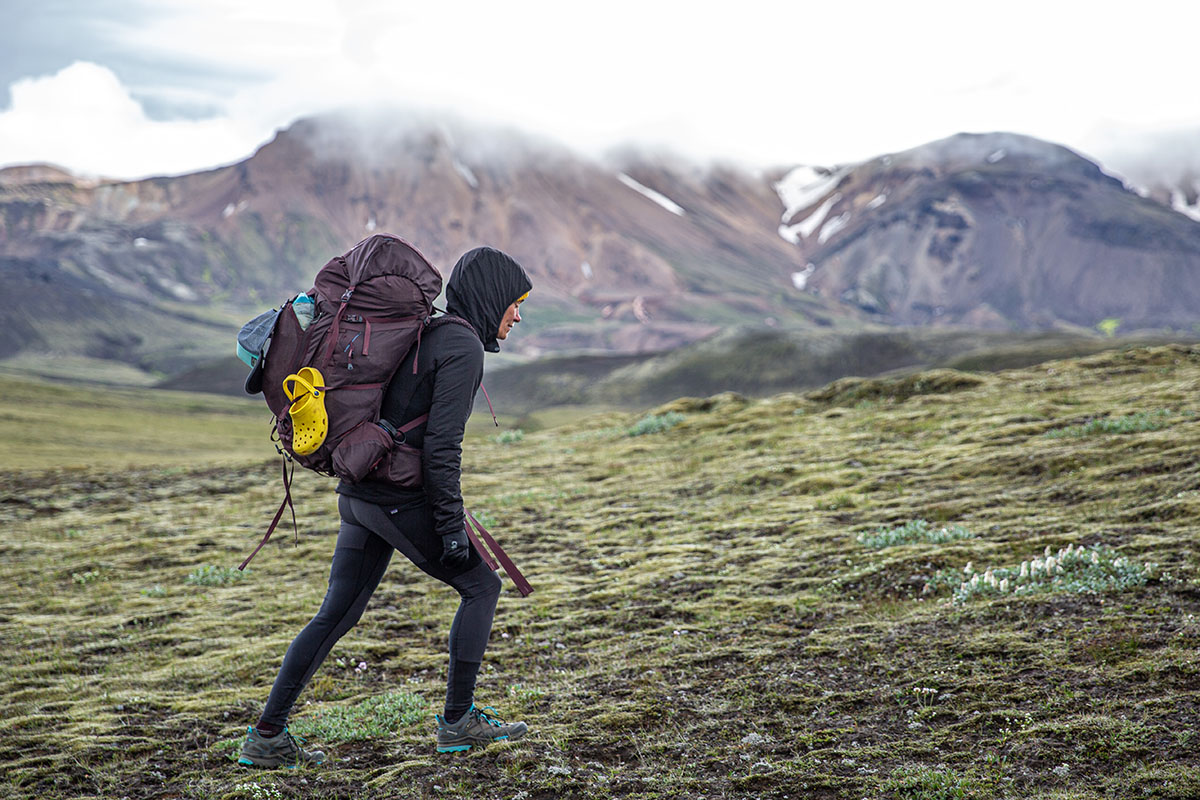
Whether or not you need high levels of support and stability is up to you, but if you anticipate doing a lot of walking or hiking in your camp shoes, it’s a good thing to consider. Weight can be a nice place to start, with heavier designs like the Chaco Z/Cloud, Keen Howser III Slide, and Bedrock Mountain Clog sitting near the top of the pack. On the flip side, light and minimalist sandals from brands like Luna and Bedrock feature relatively thin midsoles that provide far less cushioning and minimal arch support. Recovery shoes are also worth calling out here, which feature generous padding for maximizing comfort but often have a tippy feel due to their added clearance and rockered shape that minimizes contact with the ground. Finally, closures like buckles and drawcords can help boost security and minimize any unwanted movement inside your shoes.
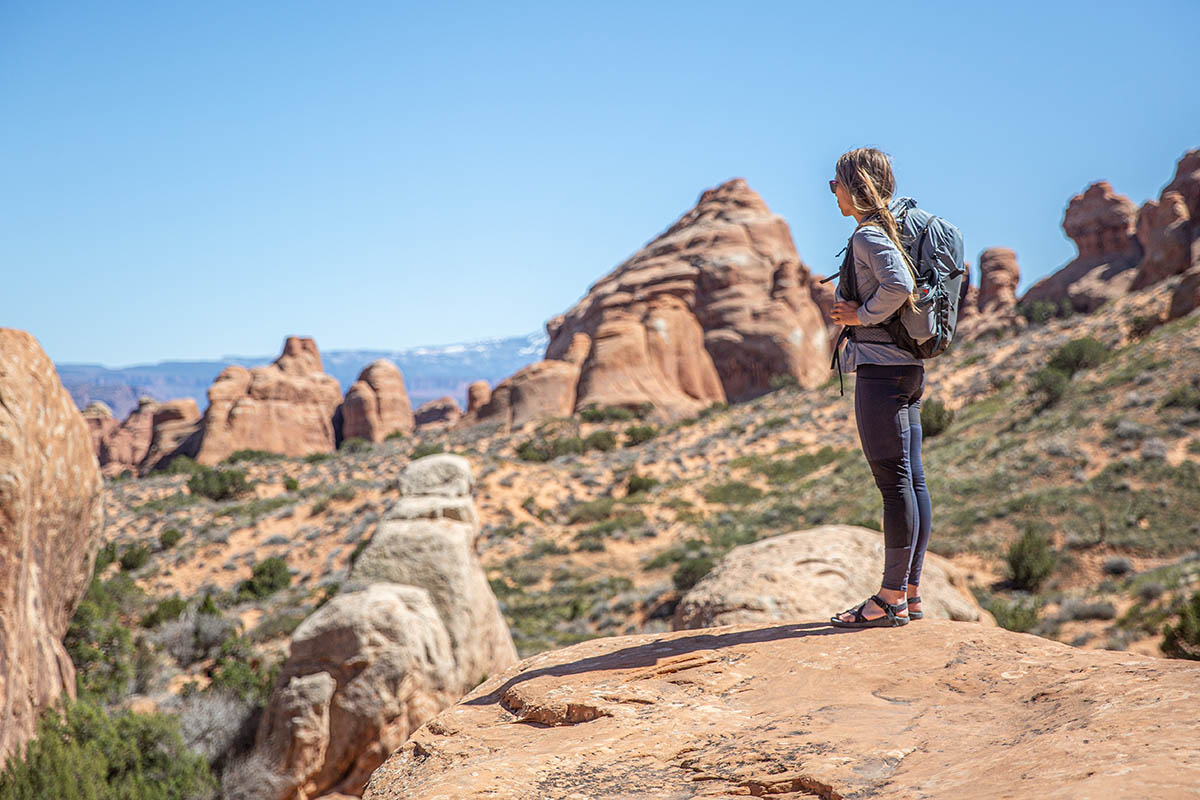
In addition to weight, traction varies considerably between camp shoes, and how much you need will largely depend on your objectives. If you’re simply looking for a feathery option to give your feet a break after long days of backpacking, a design like the Exped Camp Slipper (which features a smooth TPU sole) could be just the ticket. However, if the ability to hike in your camp shoes is appealing, it’s worth upgrading to a more substantial design, with Vibram rubber at the forefront of the market in terms of all-out grip and capability. Chaco’s in-house rubber compounds have also proven to be impressively capable. And for general around-town and light outdoor use, options like the TNF Traction Mules V, Teva ReEmber, and Keen Howser III slide strike a nice middle ground: grippy enough for short jaunts from camp but not as trail-ready as true hiking-focused designs like the Chaco/Z Cloud, Luna Leadville Pacer, and Bedrock Cairn Evo.
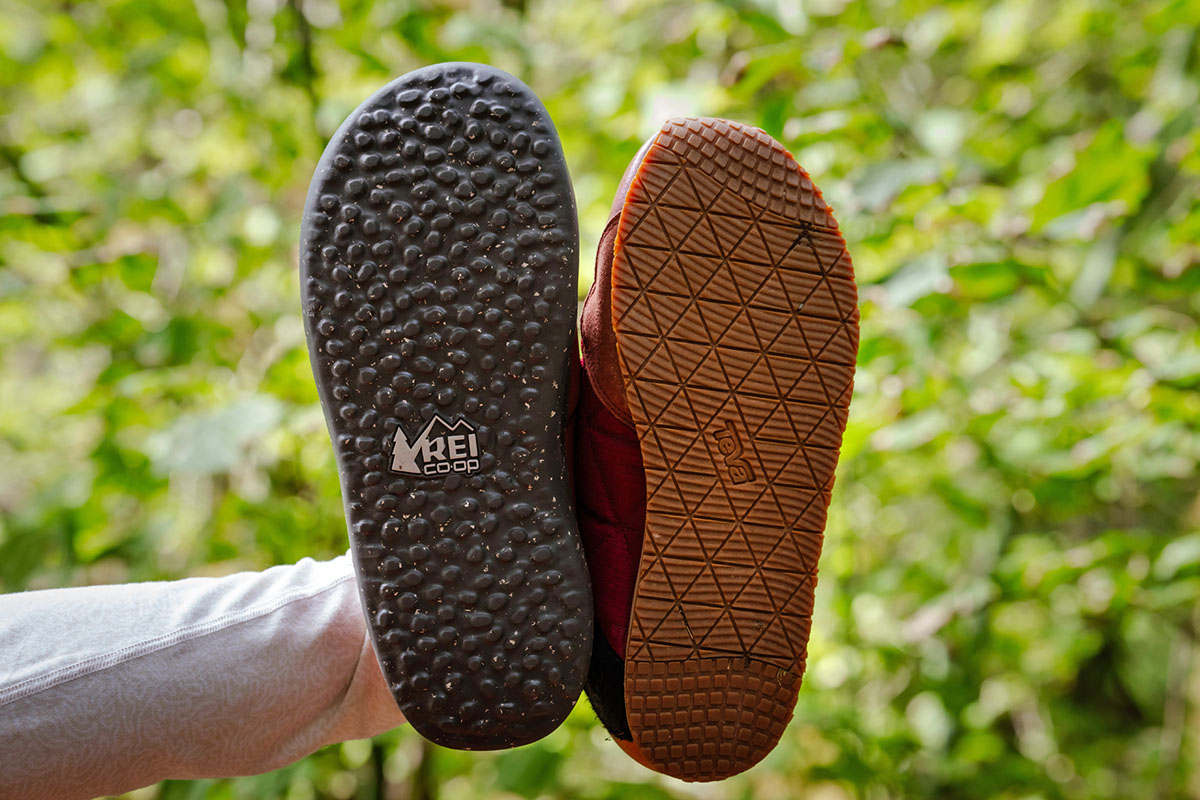
A decision between a closed-toe or open-toe camp shoe comes down to your objectives and how you prioritize protection and coverage. We love the breathability and quick-drying nature of sandals in the summer, but they leave your toes vulnerable to scratches and scrapes from rocks, roots, and other obstacles—along with bites from insects and debris working its way under your foot or between your toes. We once witnessed a Chaco-clad belayer get pulled foot-first into a rock wall when his partner fell, leaving his toes bloodied. At the other end of the spectrum are full-on booties, which we typically reserve for cold weather when the added coverage and warmth are necessary. Most slippers and clogs fall somewhere in the middle, with options like the Keen Howser III Slide and Bedrock Mountain Clog featuring beefy toe caps for fending off direct hits to the front of your foot.
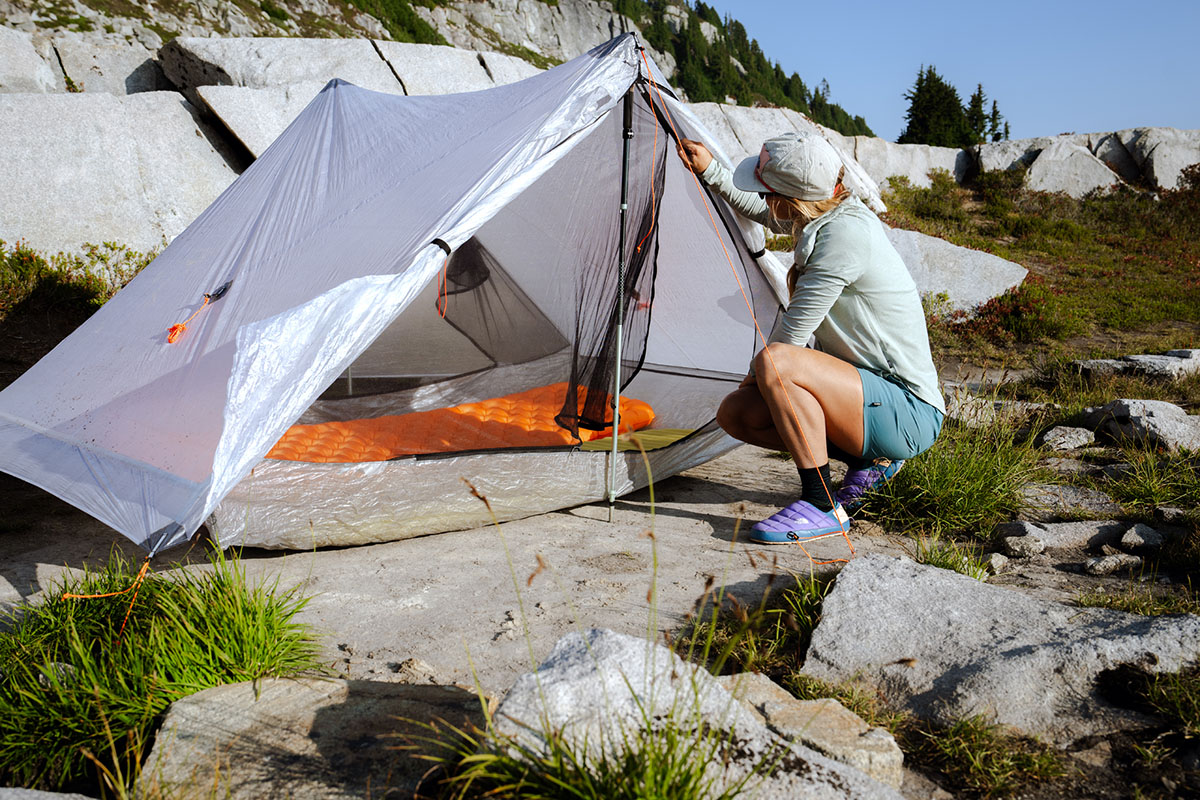
You can always throw on a pair of socks to add warmth when wearing sandals, but for shoulder-season and winter use, we turn to insulated slippers and booties. For maximum warmth at minimal weight, down-insulated designs like the Feathered Friends Down Booties are tough to beat. Synthetic insulation offers better wet-weather assurance—unlike down, it will continue to insulate when wet—making it the better option for trudging through wet grass or fending off light rain. In general, we’ve found designs like the TNF Traction Mules and Teva ReEmber land in a nice middle ground, with enough insulation to keep our feet cozy on chilly evenings at camp but not so much that we sweat out of them quickly in mild temperatures. And again, there’s always the option to add a pair of socks to boost warmth—just make sure to take that into account when sizing your shoes.
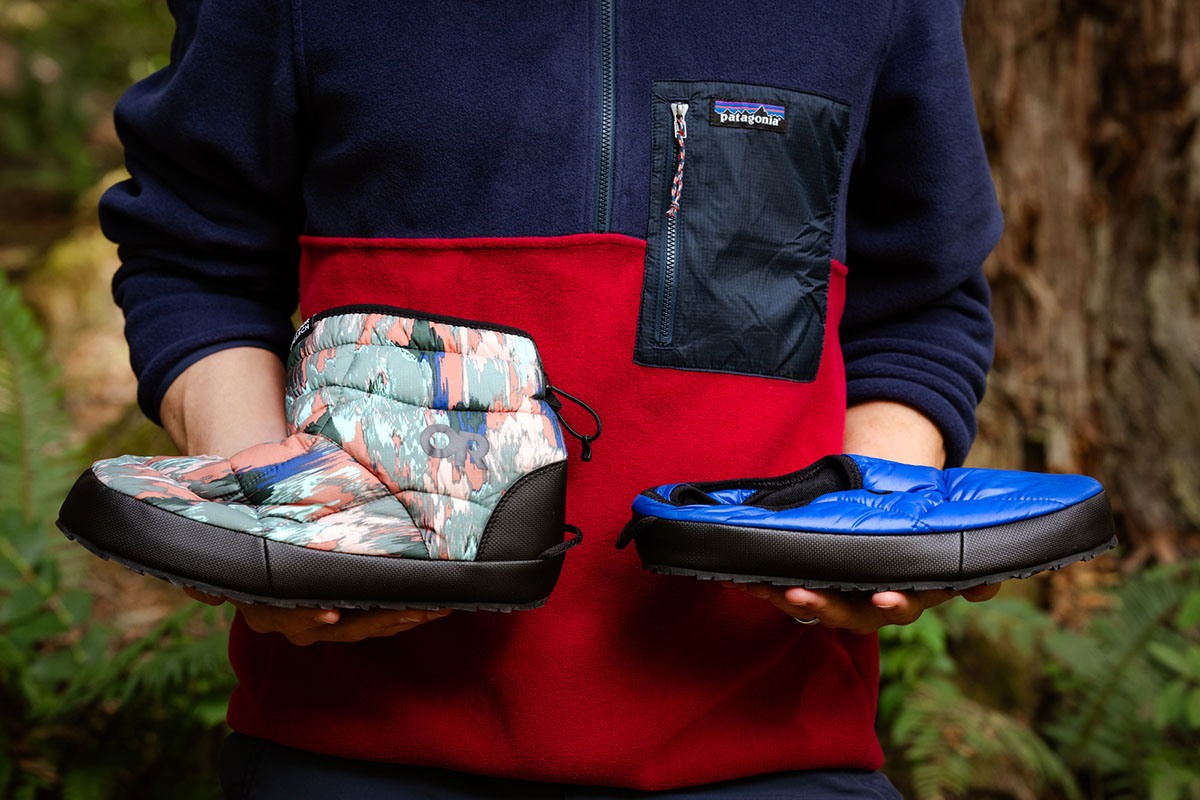
Water resistance is another matter of personal preference. If you spend a lot of time in or around water, it’s likely you’ll want a streamlined shoe that dries quickly. All of the sandals above fit the bill, along with the Crocs Classic Clog. If your primary use will be backpacking and you expect to encounter a lot of water crossings, minimalist sandals like the Luna Leadville Pacer and Bedrock Cairn Evo are great options. On the flip side, if you’re simply looking for shoes that can fend off the odd bout of light rain or snow, a design with a standard DWR coating will get the job done. For reference, we’ve worn our Teva ReEmber Slip-ons and Keen Howser III Slide on dewy mornings at camp, while washing our car, and while watering our garden, and each time, they’ve kept our feet perfectly dry—just be careful not to fully soak them, as they’ll take a while to dry.
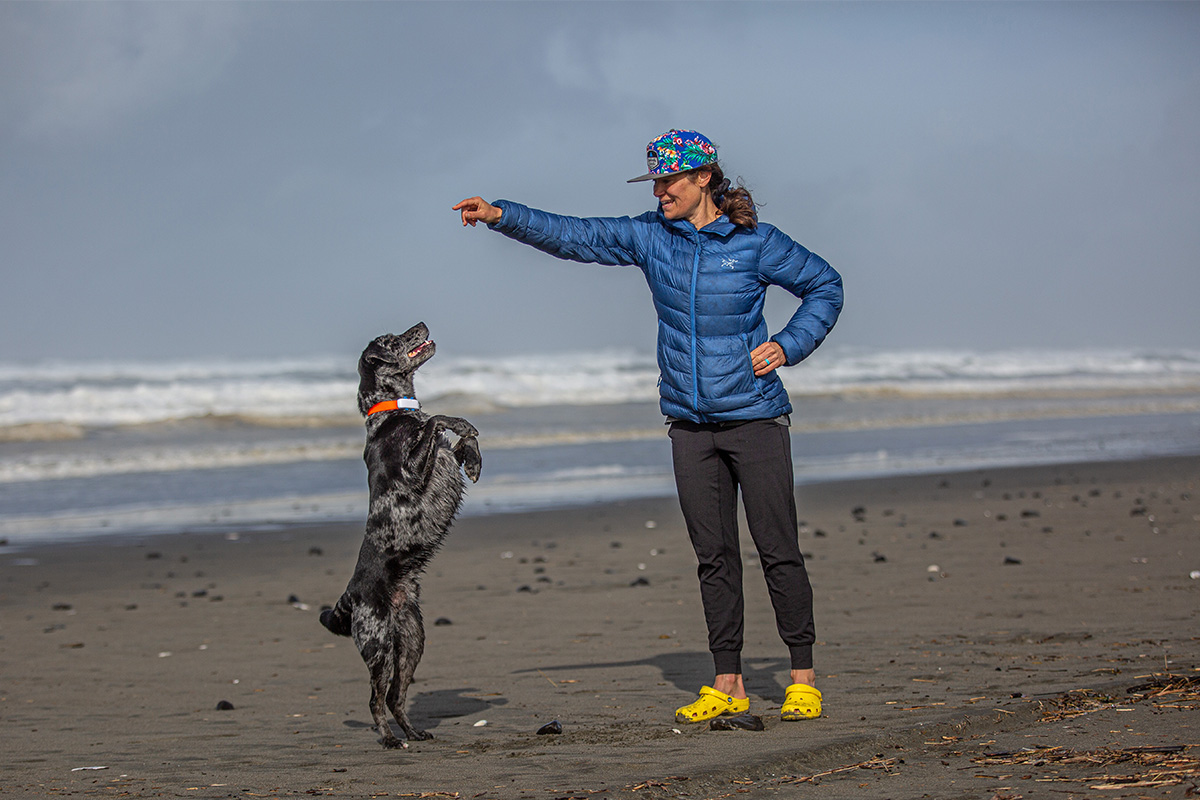
Breathability varies significantly between camp shoes, with open-toe sandals at the most ventilated end of the spectrum and full-on booties offering the least amount of airflow. Again, a decision will largely come down to where and when you plan to wear your shoes. If you’re a fair-weather backpacker looking for a shoe to tote into the backcountry, it’s probably worth opting for a breathable and quick-drying sandal that you can wear around water, hike in occasionally, and throw on at camp to give your feet a break from your hiking shoes. On the other hand, a closed-toe slipper like Teva's ReEmber is much less breathable but offers full foot coverage and enough warmth to wear casually throughout the colder months. We reserve our higher-riding booties exclusively for winter, as the added insulation and over-the-ankle height allow for minimal airflow. In the end, you’ll want to weigh factors like protection, warmth, and versatility before making a decision.
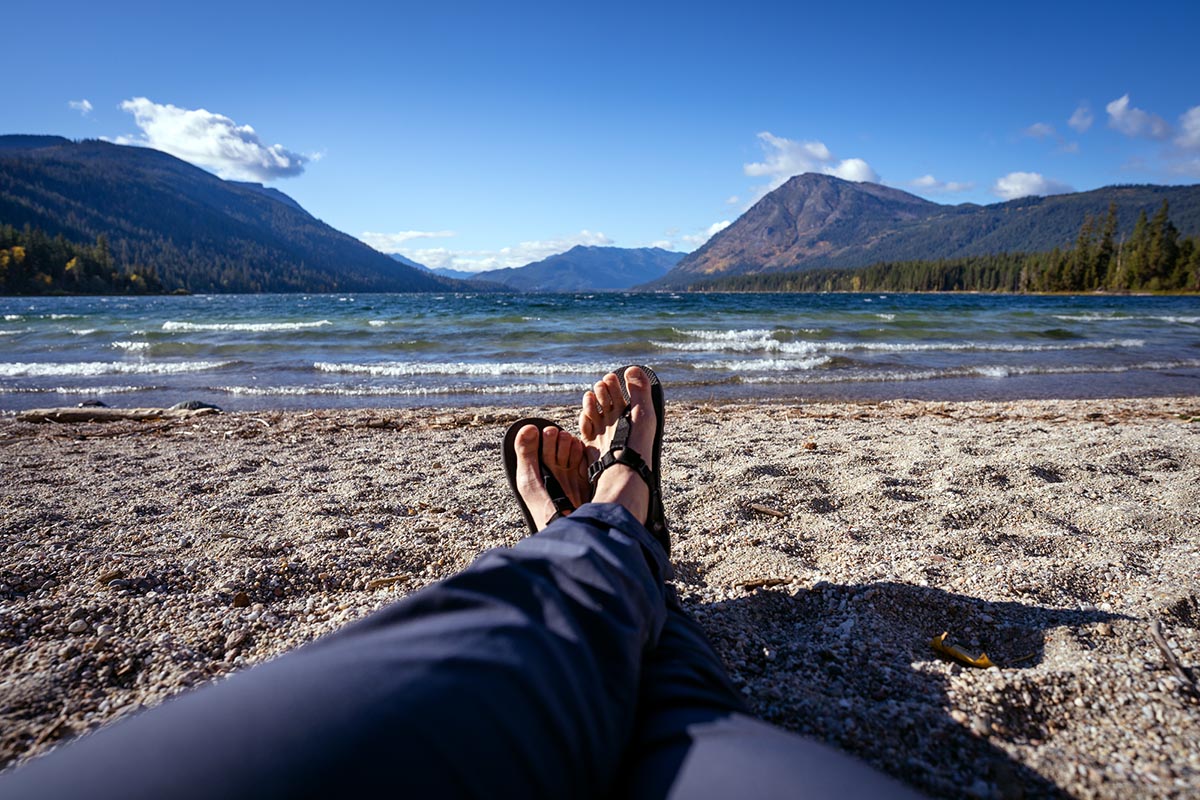
As with most performance metrics, odor resistance will depend heavily on the type of camp shoe you choose. As we mentioned, slippers and booties that cover your whole foot, like The North Face Traction Mules, Feathered Friends Down Booties, Outdoor Research Tundra Trax, and several others above, are inherently less breathable than open-toe sandals, making them more susceptible to odor buildup from sweaty feet. To combat this, some manufacturers equip their shoes with odor-resistant treatments, many of which we’ve found to be pretty effective. Keen’s Howser III, for instance, uses their Eco Anti-Odor tech that has done an admirable job keeping our pair stink-free despite daily use. If you’re concerned about odors, pairing your slippers with socks can help create a barrier, or you can purchase a deodorizer spray or Boot Bananas to slip inside your shoes between wears.
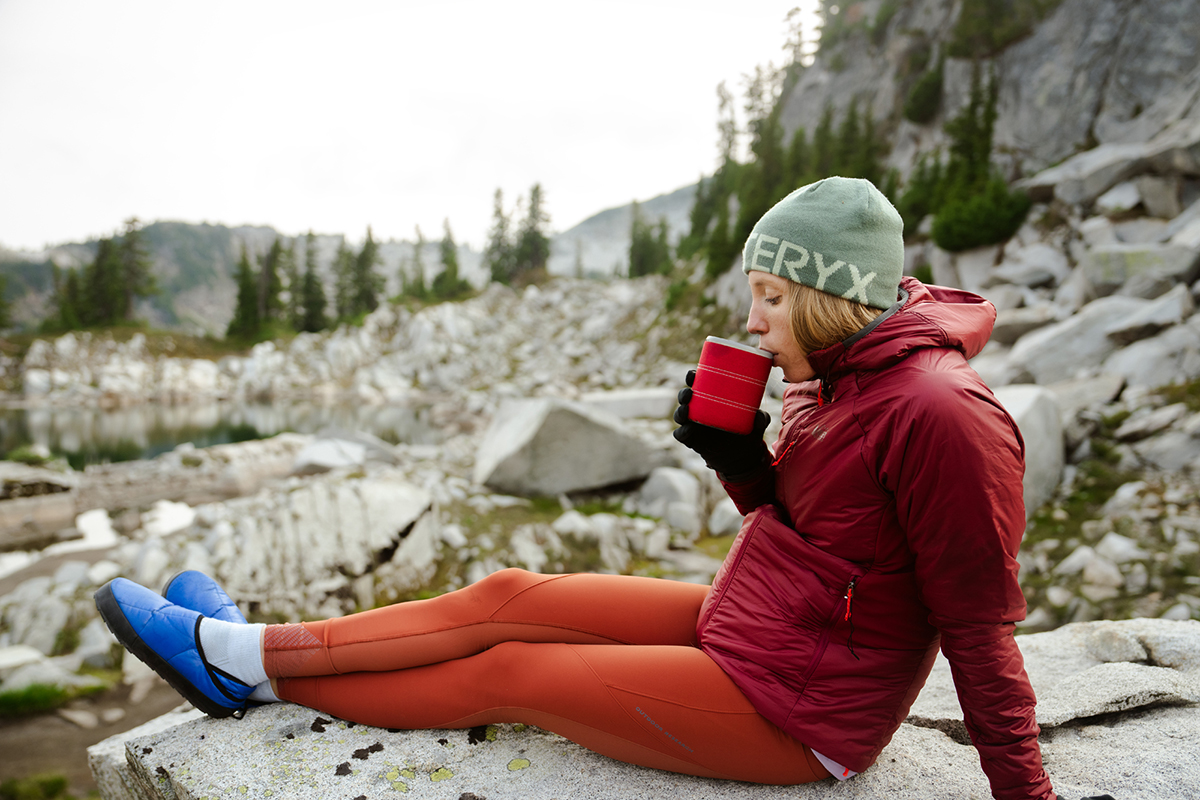
All the picks above are made by reputable brands and should stand up well to regular use. That said, some will fare better than others, and weight can be a good indicator of overall longevity. For instance, ultralight and minimalist sandals like the Luna Leadville Pacer are inherently less durable and more wear-prone than beefier and more substantial designs like Chaco’s Z/Cloud. When it comes to slippers and booties, those with smooth polyester shells—like TNF’s Traction Mules, Exped’s Camp Slipper, and Outdoor Research’s Tundra Trax Booties—tend to be the most prone to snags and tears, while Teva’s ReEmber and Keen’s Howser III Slide are almost canvas-like in feel and much less susceptible to abrasion.
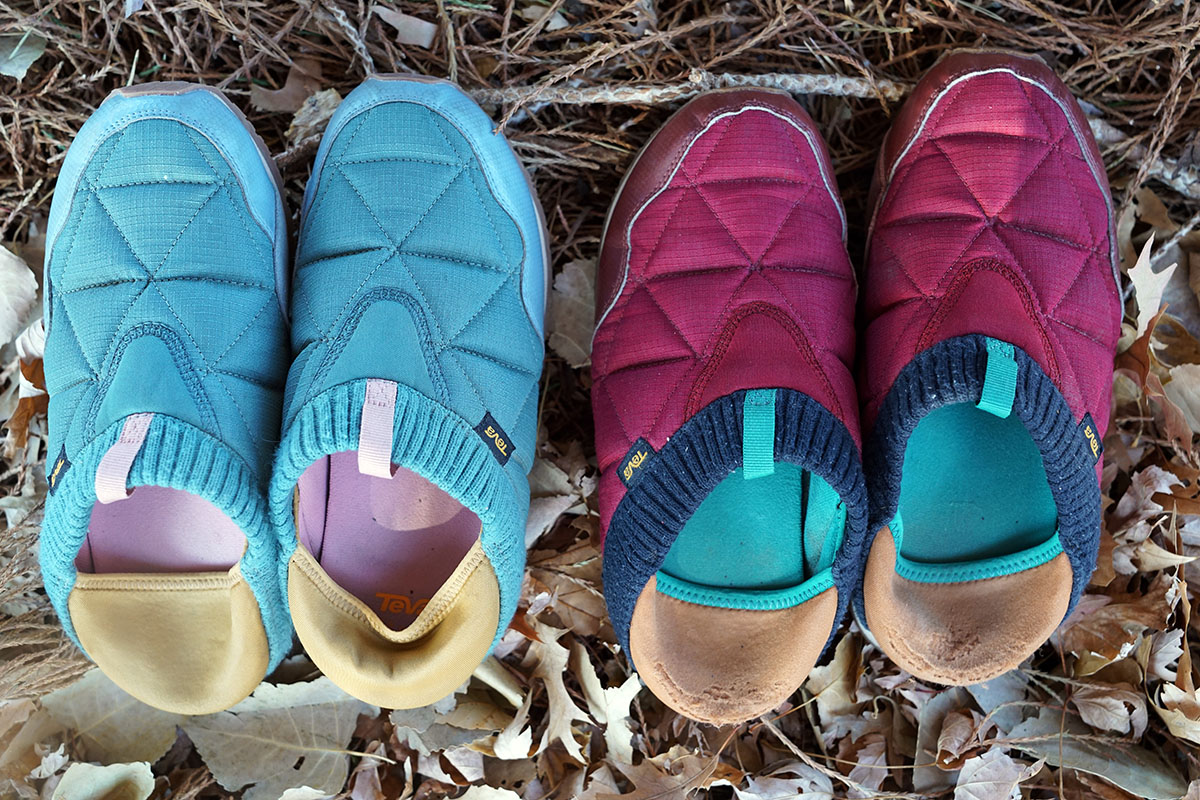
Price can be another good indicator of long-term durability, with more expensive offerings typically boasting higher-quality materials and more robust constructions that will stand up better to frequent outdoor use. For reference, the priciest option on our list is Bedrock’s Mountain Clog, which costs a steep $175 but is made with premium nubuck leather and a Vibram Megagrip outsole that is well-suited for the outdoors. There are certainly exceptions to this rule—like Crocs' $50 Classic Clog, which uses an all-foam build that we’ve found to be impressively long-lasting—but overall, you can expect heavier and pricier designs to hold up better over time.
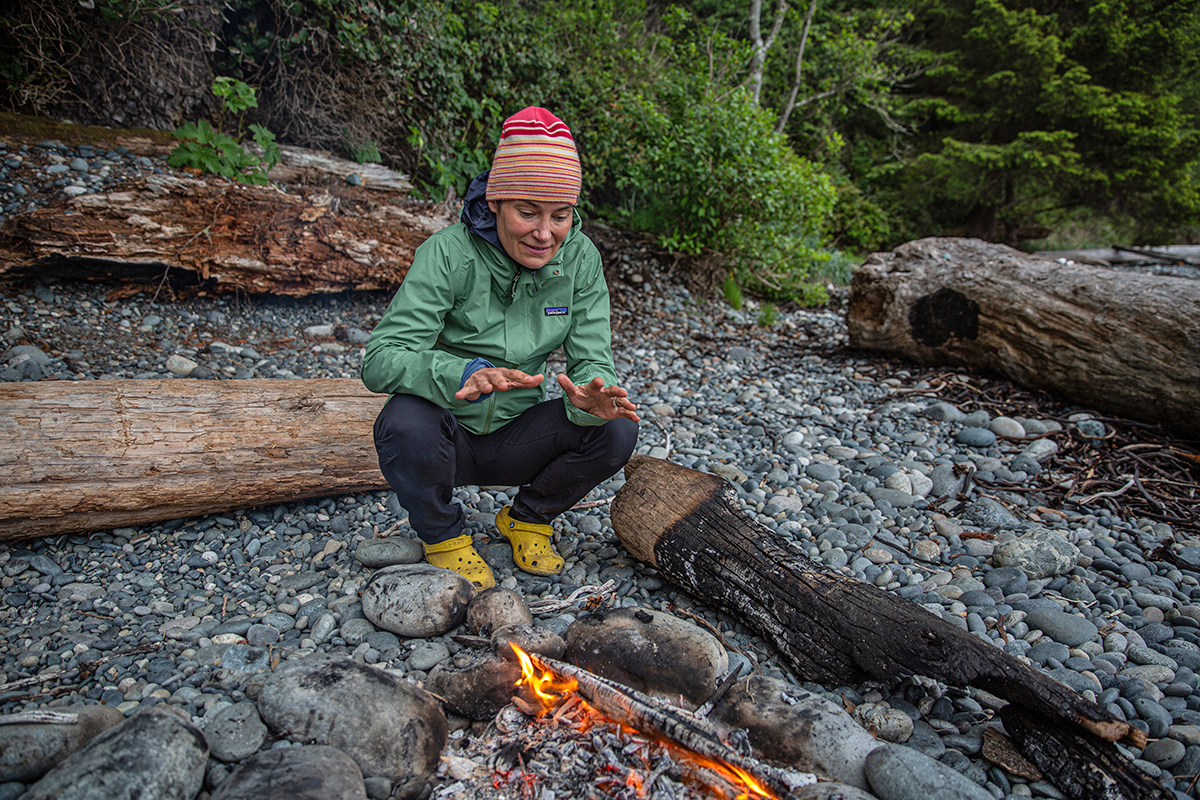
As with any pair of footwear, getting a good all-around fit is key to maximizing your camp shoes’ performance and comfort. Whenever possible, we advise trying on before you buy, as sizing can vary considerably between brands and models (it doesn't help that many camp shoes are only offered in unisex sizing). For instance, The North Face’s Traction Mules V are known to run small, while Keen’s Howser III Slide is noticeably large—enough so that we opted to size down. If you go with sandals like the Chaco Z/Cloud, Luna Leadville Pacer, or Bedrock Cairn Evo, be aware that the straps can cause pressure points and hotspots, and the only surefire way to ensure a comfortable fit is to try them on first. And those with flat feet or conditions like plantar fasciitis will want to pay particularly close attention to the overall feel of the shoe—if it feels a little unsupportive the first time you try it on, comfort will likely only deteriorate as you wear it for longer periods. Regardless of the shoes you choose, make sure to consider whether or not you’ll want to pair them with socks, and if so, how thick they’ll be.
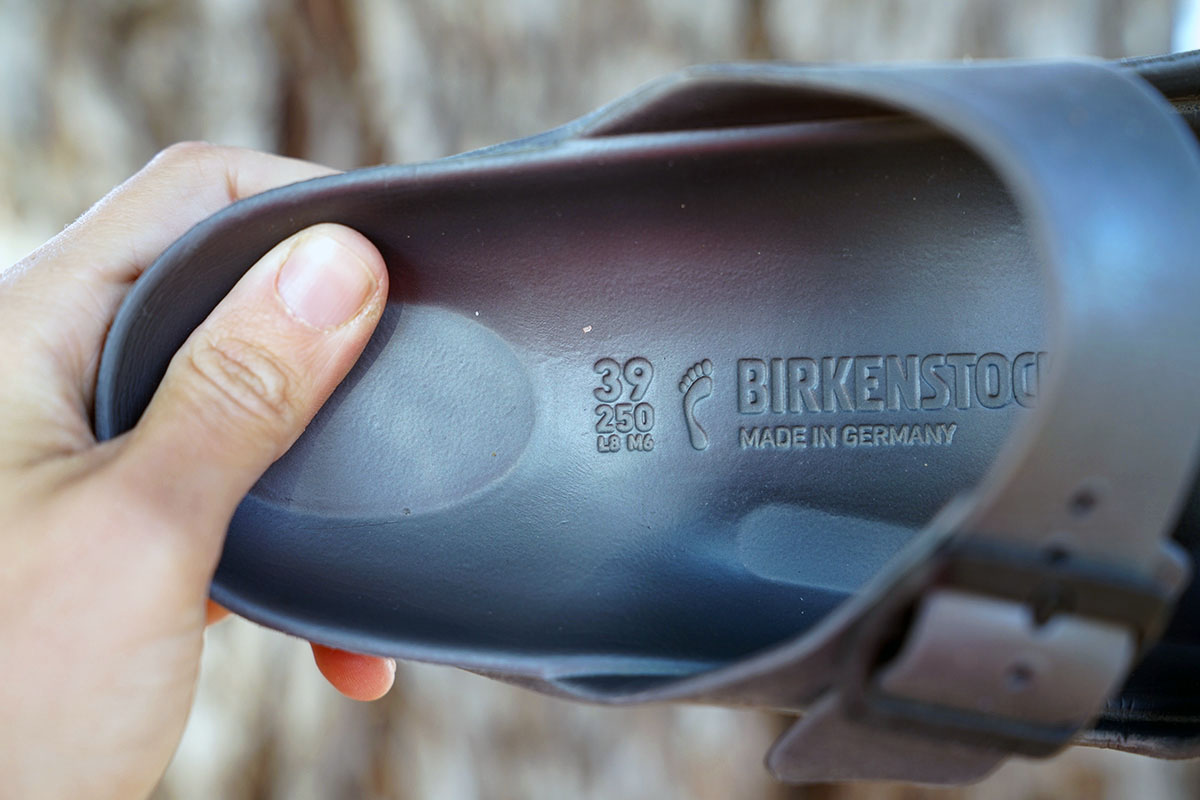
The outdoor gear market has seen a big uptick in the use of sustainable practices over the past several years, and camp shoes are no exception. Recycled materials are one of the most common measures, with brands like Teva, Outdoor Research, and The North Face at the forefront. For instance, Teva’s ReEmber Slip-Ons above use recycled materials at the collar, heel, lining, midsole, and outsole, while The North Face’s Traction Mules V features 100%-recycled PET upper and polyester insulation. The latter also employ another increasingly common sustainability measure: a PFAS-free DWR coating, which forgoes the use of harmful “forever chemicals” that are notorious for their inability to break down over time. Finally, we appreciate when brands make an effort to extend the lifespan of their products, including Chaco’s ReChaco program and Bedrock’s Re-Soul & Repair that allow you to send in your old pair of sandals and get the straps, buckles, and soles fixed or swapped.
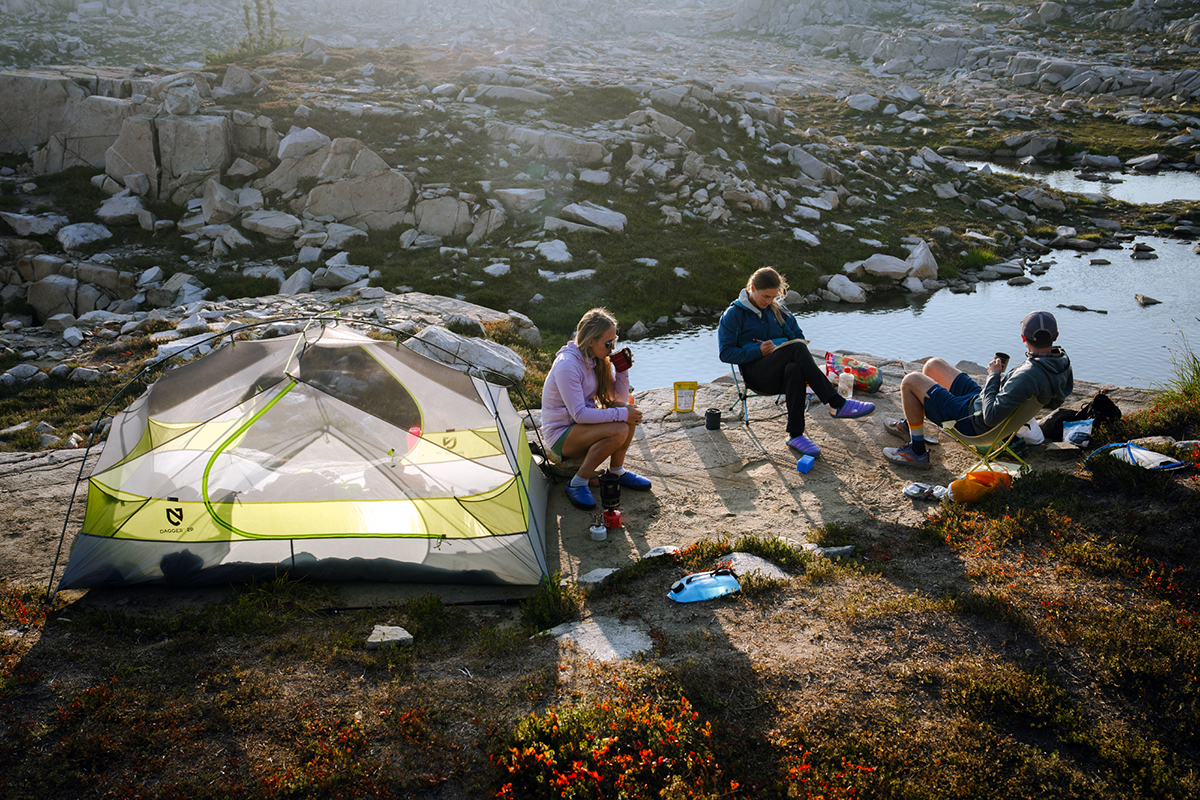
The decision on whether or not to wear socks with your camp shoes is mostly a matter of personal preference, but some designs are better suited for it than others. At the easy end are slip-ons like The North Face Traction Mules V, Teva ReEmber, and Keen Howser III Slide. We often forgo socks with our slippers when wearing them around the house, but doing so all the time may lead to odor buildup—especially if you’re prone to sweaty feet. Open-toe sandals like the Chaco Z/Cloud and Birkenstock Arizona Essentials EVA also pair well with socks, although you may have to adjust the straps to accommodate thicker designs. The only options above that don’t easily accommodate socks are those with toe straps, including the Luna Leadville Pacer and Bedrock Cairn Evo. Injinji does make designs that separate each toe, like their popular Trail Midweight Mini-Crew, but not everyone will like the looks or effort required to put them on. The biggest takeaway is that it’s a good idea to think about compatibility before making a purchase.
Back to Our Top Camp Shoe Picks Back to Our Camp Shoe Comparison Table